 | –≠–ª–µ–∫—Ç—Ä–æ–Ω–Ω—ã–π –∫–æ–º–ø–æ–Ω–µ–Ω—Ç: SZA1000H | –°–∫–∞—á–∞—Ç—å:  PDF PDF  ZIP ZIP |

DATA SHEET
Product specification
File under Integrated Circuits, IC01
1998 Feb 16
INTEGRATED CIRCUITS
SZA1000
QIC digital equalizer
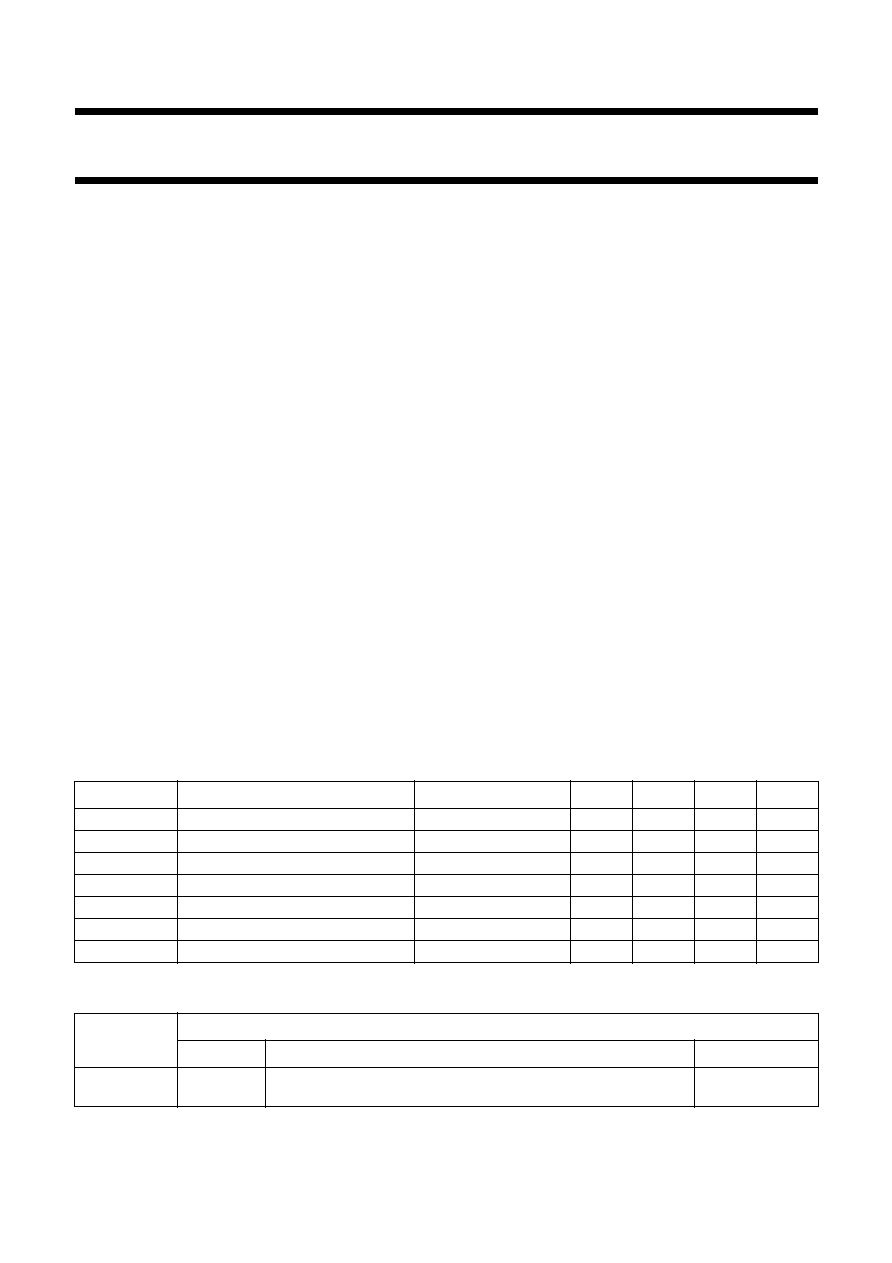
1998 Feb 16
2
Philips Semiconductors
Product specification
QIC digital equalizer
SZA1000
FEATURES
∑
3-wire serial interface for programming and status
reading
∑
Suitable for MFM (Modified Frequency Modulation),
RLL 1,7 (Run Length Limited) and similar codes
∑
Transfer rates with MFM code from
250 kbits/s to 4 Mbits/s
∑
Transfer rates with RLL(1,7) code from
500 kbits/s to 12 Mbits/s
∑
Programmable FIR (Finite Impulse-Response) filter
makes it possible to equalize complex and asymmetric
channel impulse responses
∑
Programmable fixed and tracking qualification
thresholds provide reliable data recovery in read mode,
and reliable bad sector detection in verify mode
∑
Read pulse output for floppy tape drives
∑
Digital data synchronizer based on digital PLL with
maximum likelihood detector for a better error rate than
can be achieved with conventional analog circuits
∑
Data verification can be used (with the maximum
likelihood detector switched off) to find bad sectors on
drives with conventional read electronics
∑
Servo stripe detection for TR4, QIC3080 and similar
formats
∑
Gap detector
∑
2 programmable current sources
∑
Peak-to-peak amplitude detector with lowpass filter for
servo burst reading
∑
Fully digital PLL for clock and data recovery:
≠ Fully programmable behaviour
≠ No external components, no tolerance problems
≠ Programmable window shift
≠ Fast run-in capability
≠ Ideal zero phase restart.
∑
Parallel 8-bit input and output for product development
and production testing
∑
Programmable WEQ (write equalization) circuit with
transfer rates of up to 2 Mbits/s for floppy tape drives
and up to 8 Mbits/s for drives with internal controllers.
GENERAL DESCRIPTION
The SZA1000 is a single chip digital equalizer for single
channel QIC (Quarter Inch Cartridge) systems with
MR (Magneto Resistive) heads. It can be used with
QIC 3010, QIC 3020, QIC 3080, QIC 3095, Travan 2, 3, 4
and 5, and similar formats.
It replaces a pulse detector, programmable filter and data
synchronizer, and adds a FIR filter to the conventional
analog solution. This makes it possible to equalize
yoke-type MR heads as well as SIG (Sensor In Gap)
MR heads.
QUICK REFERENCE DATA
ORDERING INFORMATION
SYMBOL
PARAMETER
CONDITIONS
MIN.
TYP.
MAX.
UNIT
V
DDD1
; V
DDD2
digital supply voltage
4.5
5.0
5.5
V
V
DDA1
; V
DDA2
analog supply voltage
4.5
5.0
5.5
V
I
DDD1
; I
DDD2
digital supply current
f
s
= 24 MHz
-
32
-
mA
I
DDA1
; I
DDA2
analog supply current
-
50
-
mA
f
clk(CLKIN)
read circuit clock frequency
-
24
24
MHz
f
clk(WEQCLK)
WEQ circuit clock frequency
-
24
36
MHz
T
amb
ambient operating temperature
0
-
70
∞
C
TYPE
NUMBER
PACKAGE
NAME
DESCRIPTION
VERSION
SZA1000H
QFP44
plastic quad flat package; 44 leads (lead length 1.3 mm)
body 10
◊
10
◊
1.75 mm
SOT307-2
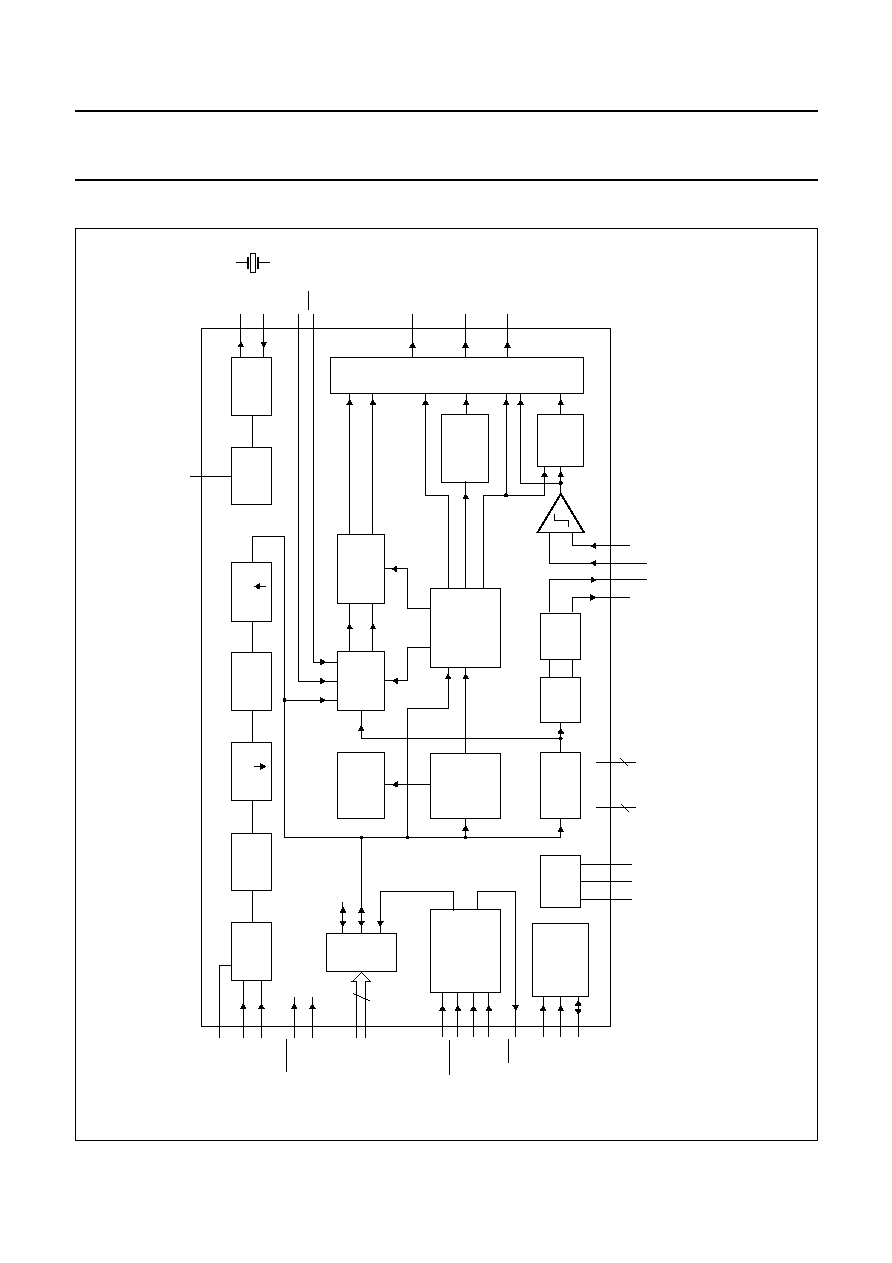
1998
Feb
16
3
Philips Semiconductors
Product specification
QIC digital equalizer
SZA1000
This text is here in white to force landscape pages to be rotated correctly when browsing through the pdf in the Acrobat reader.This text is here in
_
white to force landscape pages to be rotated correctly when browsing through the pdf in the Acrobat reader.This text is here inThis text is here in
white to force landscape pages to be rotated correctly when browsing through the pdf in the Acrobat reader. white to force landscape pages to be ...
BLOCK DIAGRAM
a
ndbook, full pagewidth
MGG582
XOSC/
CLK IN
I/O
MUX
MUX
WRITE
EQUALIZATION
SERIAL
INTERFACE
IDAC
LPF
15 kHz
DIFF
PLL
AMPL.
DETECTOR
DAC
MAXIMUM
LIKELIHOOD
DETECTOR
LPF
8 MHz
AMPL.
QUALIFIER
+
GAP
DETECTOR
STRIPE
DETECTOR
READ
PULSE
ADC
HPF
FIR
CLK
DIV
LPF
R
INTERPOL
R
22
38 1
2
43
40
CMPB
EYEA
CMPA
EYEB
39 44
24
23
36
4
3
9
10
33
32
31
30
37
8, 28,
34, 41
5, 26,
35, 42
VSSD1
VDDD1
VSSD2
VDDD2
VSSA1
VDDA1
VSSA2
VDDA2
11 to 18
8
27
25
21
SRD/RD
19
LTD
20
RG
6
CLKIN
7
CLKOUT
RRC
GAP/STRIPE
SDIO
SCLK
SDEN
WEQEN
WEQCLK
WDIN
AUXBUS0/WDOUT
TEST
INB
INA
Vref
RESET
WGATE
WGX
AUXBUS1
to
AUXBUS7
29
PACLK
SZA1000
IO2
IO1
Rref
4
4
Fig.1 Block diagram.

1998 Feb 16
4
Philips Semiconductors
Product specification
QIC digital equalizer
SZA1000
PINNING
SYMBOL
PIN
DESCRIPTION
IO1
1
programmable current source
IO2
2
programmable current source
WEQEN
3
write equalization circuit enable input
WGATE
4
write gate input; active LOW
V
DDD1
5
digital supply voltage
CLKIN
6
external clock or crystal oscillator input
CLKOUT
7
crystal oscillator output
V
SSD1
8
digital ground
WEQCLK
9
write equalization circuit clock input
WDIN
10
write equalization circuit data input
AUXBUS0/WDOUT
11
bit 0 auxiliary I/O bus or write equalization output to write amplifier
AUXBUS1
12
bit 1 auxiliary I/O bus
AUXBUS2
13
bit 2 auxiliary I/O bus
AUXBUS3
14
bit 3 auxiliary I/O bus
AUXBUS4
15
bit 4 auxiliary I/O bus
AUXBUS5
16
bit 5 auxiliary I/O bus
AUXBUS6
17
bit 6 auxiliary I/O bus
AUXBUS7
18
bit 7 auxiliary I/O bus
LTD
19
fast lock to data input; active LOW
RG
20
read gate input
GAP/STRIPE
21
gap or stripe detector output
SDIO
22
serial interface data input and output
SDEN
23
serial interface enable input
SCLK
24
serial interface clock input
RRC
25
read reference clock output
V
DDD2
26
digital supply voltage
SRD/RD
27
synchronized read data or read data output
V
SSD2
28
digital ground
PACLK
29
pre-amp clock output
RESET
30
reset input; active LOW
TEST
31
test input; connect to ground
INA
32
analog signal from read amplifier; positive input
INB
33
analog signal from read amplifier; negative input
V
SSA1
34
analog ground
V
DDA1
35
analog supply voltage
WGX
36
extended write gate output for floppy tape drives; active LOW
V
ref
37
positive A/D reference voltage input
R
ref
38
connect external resistor
EYEA
39
differentiated signal; positive output
CMPA
40
comparator for read pulse; positive input
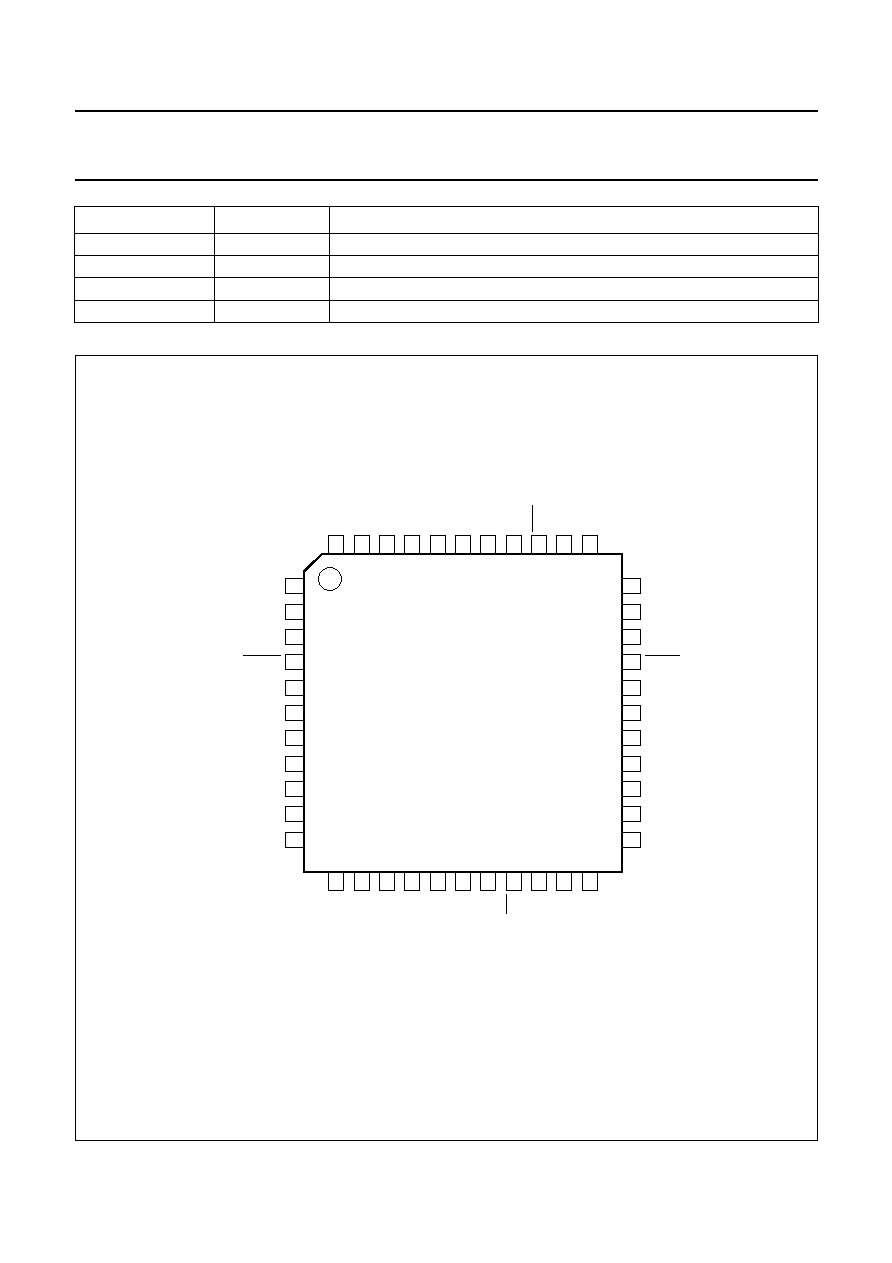
1998 Feb 16
5
Philips Semiconductors
Product specification
QIC digital equalizer
SZA1000
V
SSA2
41
analog ground
V
DDA2
42
analog supply voltage
CMPB
43
comparator for read pulse; negative input
EYEB
44
differentiated signal; negative output
SYMBOL
PIN
DESCRIPTION
Fig.2 Pin configuration.
handbook, full pagewidth
SZA1000
MGD794
1
2
3
4
5
6
7
8
9
10
11
IO1
IO2
WEQEN
WGATE
VDDD1
CLKIN
CLKOUT
VSSD1
WEQCLK
WDIN
AUXBUS0/WDOUT
INB
INA
TEST
RESET
PACLK
VSSD2
SRD/RD
VDDD2
RRC
SCLK
SDEN
33
32
31
30
29
28
27
26
25
24
23
12
13
14
15
16
17
18
19
20
21
22
AUXBUS1
AUXBUS2
AUXBUS3
AUXBUS4
AUXBUS5
AUXBUS6
AUXBUS7
LTD
RG
GAP/STRIPE
SDIO
EYEB
CMPB
V
DDA2
V
SSA2
CMPA
EYEA
R
ref
V
ref
WGX
V
DDA1
V
SSA1
44
43
42
41
40
39
38
37
36
35
34

1998 Feb 16
6
Philips Semiconductors
Product specification
QIC digital equalizer
SZA1000
FUNCTIONAL DESCRIPTION
Clock oscillator and divider
The clock source for the SZA1000 can be a crystal
connected between pins 6 and 7, or an external clock
signal connected to pin 6. This clock frequency is divided
by a number programmable between 1 and 8
(see Tables 27 and 28). The resulting frequency, f
s
, is
used as clock input to all on-chip circuits except the write
equalizer. The frequency of the PACLK output signal
(pin 29) is equal to f
s
.
ADC
The 8-bit ADC has a differential input. The total ADC
conversion range is 1.6 V (p-p; differential). The ADC
sample rate is equal to f
s
.
High-pass filter after the ADC
This is a first order filter with a cut-off frequency of
It removes the DC component of the signal.
Low-pass filter
This low-pass filter is an even symmetrical FIR (Finite
Impulse Response) filter. The number of taps depends on
the sample rate reduction factor R (see Tables 30 and 31).
The filter has 8 taps for R = 1 or 14 taps for R = 2 (see
Table 7). The middle taps have a fixed coefficient value of
+128, the coefficients of the other taps are programmable
in the range
-
128 to +127 (see Table 6).
FIR
This transversal filter has 6 taps with the sample rate equal
to f
s
(R = 1), or 11 taps with the sample rate equal to
1
/
2
f
s
(R = 2). Tap 10 has a fixed coefficient value of +64, the
coefficients of the other taps are programmable between
-
64 and +63 (see Table 2). The filter has 19 signal delay
sections. The position of each tap can be selected from a
subset of the 20 possible positions (see Tables 3 and 4).
Interpolator
If a sample rate of
1
/
2
f
s
has been selected for the FIR
(R = 2), it is increased once again to f
s
at the interpolator.
f
s
1608
-------------
Amplitude detector
This circuit has a separate rectifier and a positive and
negative peak detector.
Typical rise time (0 to 70%) for a normal MFM or
RLL 1,7 code input signal is
, typical decay time
(100 to 30%) is programmable between
and
(see Tables 10 and 11).
The output is an 8-bit number that can be polled via the
serial interface. In addition, the peak-to-peak value is
calculated and filtered by a first order low-pass filter with a
cut-off frequency of
Both the filtered and unfiltered amplitudes can be read via
the serial interface (see Table 44) or via the parallel output
bus.
Amplitude qualifier
A peak is considered valid if its amplitude is above a
qualification threshold. Separate qualification thresholds
are used for the positive and negative peaks. Each
threshold is the greater of:
∑
a programmable level (QUAL_FIX_ POS and
QUAL_FIX_NEG; control register addresses 24 and 25)
∑
a programmable fraction (
1
/
2
,
3
/
8
,
1
/
4
,
1
/
8
or 0;
see Tables 9 and 12) of the peak amplitude of the
incoming signal.
Gap detector
When the peak-to-peak amplitude of the measured signal
is below a preset limit (GAP_THRESH; control register
address 28), the gap detector output is HIGH, otherwise
LOW (GAP output on pin 21 must be selected; see
Table 22).
1
f
s
----
500
f
s
----------
400
f
s
----------
f
s
3217
-------------
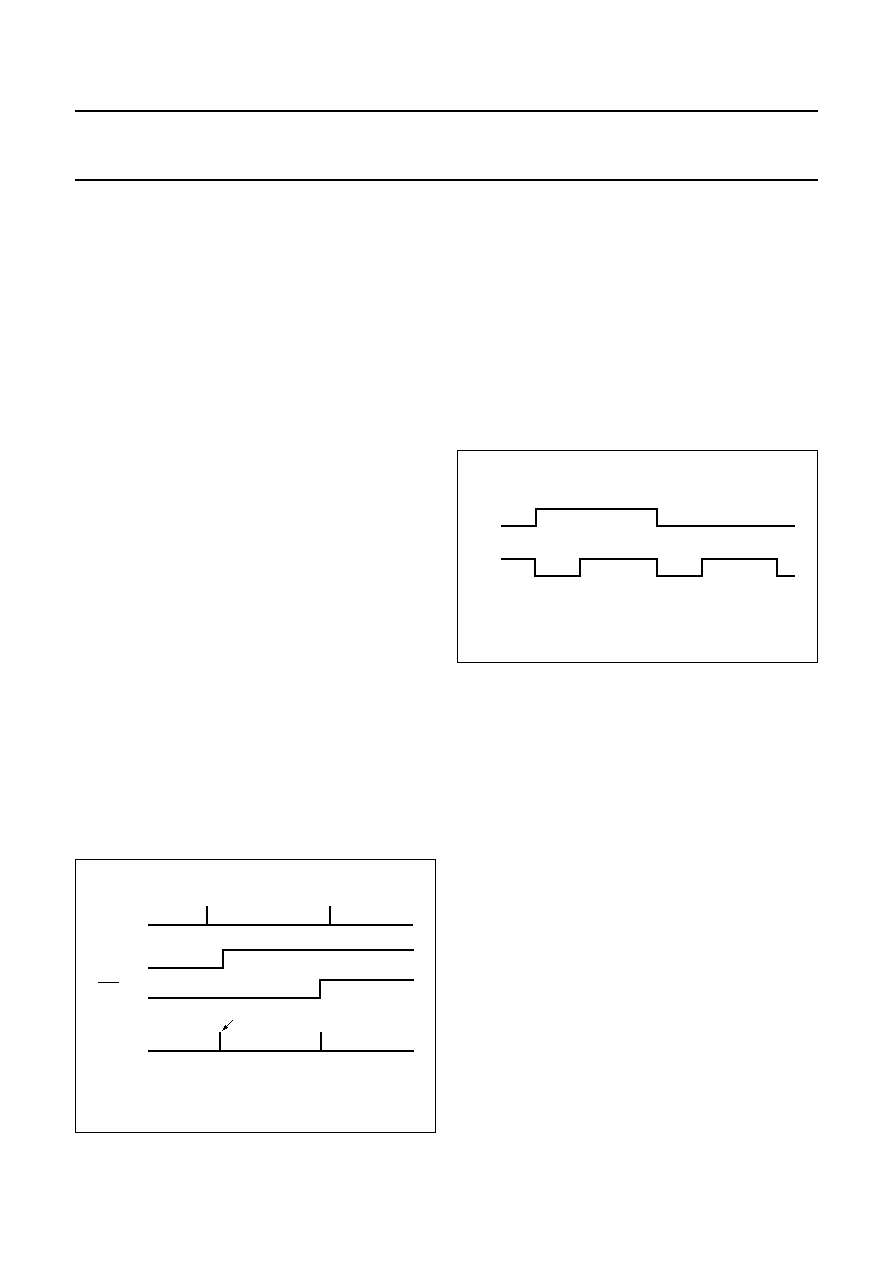
1998 Feb 16
7
Philips Semiconductors
Product specification
QIC digital equalizer
SZA1000
Stripe detector
This circuit is used to signal the stripes in QIC 3080,
QIC 3095 and TR4 servo formats (STRIPE output on
pin 21 must be selected; see Table 22). A frequency
detector counts the peaks above the qualification
threshold (see Table 29). An input signal containing
frequencies within
±
25% of the programmable nominal
frequency will be detected as a stripe. The microcontroller
can then poll the amplitude of the following burst via the
serial interface.
Differentiator
This function is realized by subtracting samples. The delay
between samples is programmable between 1 and 6
periods of f
s
, split into two parts to provide a balanced
delay between the differentiated and non-differentiated
signals (see Tables 24 to 26).
The PLL
This is a fully digital PLL (Phase Lock Loop) with a
programmable nominal frequency (see Tables 35 and 36),
zero phase restart, programmable window shift
(WIN_SHIFT; control register address 42) and a loop filter
with two separate programmable settings.
The PLL output reference clock is the RRC signal (pin 25;
see Table 34). The frequency of this signal is rounded in
time to f
s
. The PLL is switched to the nominal frequency if
RG (pin 20) is LOW, and makes a zero phase restart at the
first detected peak after RG goes HIGH.
The LTD input (pin 19) is used to select between the two
loop filter settings (see Tables 37 to 42). This allows for
fast lock-in during preamble, before switching to a lower
loop bandwidth for maximum data reliability (see Fig.3).
Fig.3 PLL timing diagram.
handbook, halfpage
MGG583
INPUT
SIGNALS
RG
PLL
MODE
preamble
data
nominal
frequency
fast lock-in
normal read mode
zero phase restart
LTD
The maximum likelihood detector
This detector calculates the most likely position of the
peaks in the signal. It checks for (d,k) code constraints,
and for alternating peaks. If an error is detected, the `most
likely' correction is implemented.
Separate corrections can be enabled or disabled.
The SRD output of the maximum likelihood detector is
valid during the rising edge of the RRC signal (see Fig.4).
The maximum likelihood detector is used only to generate
the SRD signal, and not to generate the time continuous
RD pulse.
The DAC
This is an internal differential 8-bit DAC operating at f
s
.
The LPF after the DAC
This analog LPF filters the time quantized signal from the
DAC to retain a time continuous signal. This provides more
accurate timing of the detected zero crossings in the RD
pulse output.
The LPF is a second order active filter with a cut-off
frequency of 8 MHz.
The read pulse circuit
A peak in the equalized signal at the interpolator output
generates a read pulse. The peak is detected if a zero
crossing occurs in the filtered signal after the DAC while
the non-differentiated signal is above the qualification
threshold.
Uncommitted current sources
Two uncommitted 5-bit programmable current sink DACs
(0 to 2 mA) are available as IO1 and IO2 (see Table 20 for
programming). These could be used, for example, to drive
the tape hole detector circuit.
Fig.4 SRD/RRC timing.
handbook, halfpage
MGG584
SRD
RRC

1998 Feb 16
8
Philips Semiconductors
Product specification
QIC digital equalizer
SZA1000
Parallel state bus
All internal digital signals can be monitored via an 8-bit
parallel bus. An external DAC or an evaluation tool such as
a phase error logger for TIA (Time Interval Analyzer),
drop-out and symmetry measurements can be connected
to this bus for evaluation purposes (see Table 34).
Write equalization
This circuit has an independent clock input WEQCLK at
pin 9.
Write equalization can be programmed to conform to a
number of formats including QIC 3010, QIC 3020,
QIC 3080, QIC 3095, QIC 5010, Travan 2, Travan 3 and
Travan 4.
This is achieved by programming the circuit to divide a
channel bit-cell into 2, 3 or 6 time slots (see Tables 13
and 14). The external WEQ clock frequency should be
selected such that an integer number of between 1 and 8
clock periods fits in a time slot (see Tables 18 and 19).
The width and position of the inserted write pulse can be
programmed (see Tables 15 to 17).
The write equalization circuit input and output signals can
be independently programmed to be in either WD or WDI
format (see Table 15).
For QIC 3010 or 3020, the recording signal is typically
generated by a circuit that uses a separate crystal.
An input buffer with variable delay is used to prevent errors
occurring in the recorded signal. This buffer is set to its
nominal position when writing begins.
Signals longer than a data block can be recorded during
formatting. To avoid overloading the time buffer, the circuit
can resynchronize automatically during gaps in the
QIC 3010 or 3020 format.
Serial interface
The serial interface uses 8-bit addresses and 8-bit data.
Its timing is shown in Fig.5. IC mode settings, filter
coefficients, scale factors and thresholds can be loaded
via the serial interface.
Measured signal amplitude, for example Burst level
measurement at QIC 3095 or AGC control by the
microcontroller, and the actual PLL frequency can be read
via the serial interface. To read data from the status
registers, hex address FF must be transmitted along with
the required data code. The IC will then respond with the
contents of the appropriate 8-bit status register
(see Table 44).

1998
Feb
16
9
Philips Semiconductors
Product specification
QIC digital equalizer
SZA1000
This text is here in white to force landscape pages to be rotated correctly when browsing through the pdf in the Acrobat reader.This text is here in
_
white to force landscape pages to be rotated correctly when browsing through the pdf in the Acrobat reader.This text is here inThis text is here in
white to force landscape pages to be rotated correctly when browsing through the pdf in the Acrobat reader. white to force landscape pages to be ...
Fig.5 Serial I/O timing diagrams.
k
, full pagewidth
MGG585
A7
A6
A5
A4
A3
A2
A1
A0
D7
D6
D5
D4
D3
D2
D1
D0
3-STATE
WRITE SETTINGS
SDEN
SCLK
SDIO
A7
A6
A5
A4
A3
A2
A1
A0
D7
D6
D5
D4
D3
D2
D1
D0
D7
D6
D5
D4
D3
D2
D1
D0
3-STATE
READ STATUS
SDEN
SCLK
SDIO
ADDRESS AND DATA FROM MICROCONTROLLER
DATA OUT FROM DEVICE

1998 Feb 16
10
Philips Semiconductors
Product specification
QIC digital equalizer
SZA1000
CONTROL REGISTER
Control register settings
The control register is accessible through the serial interface and contains 46 8-bit entries as shown in Table 1.
Table 1
Control register
ADDRESS
NAME
DESCRIPTION
0
FIR_VAL0
FIR tap 0 coefficient value (see Table 2)
1
FIR_VAL1
FIR tap 1 coefficient value
2
FIR_VAL2
FIR tap 2 coefficient value
3
FIR_VAL3
FIR tap 3 coefficient value
4
FIR_VAL4
FIR tap 4 coefficient value
5
FIR_VAL5
FIR tap 5 coefficient value
6
FIR_VAL6
FIR tap 6 coefficient value
7
FIR_VAL7
FIR tap 7 coefficient value
8
FIR_VAL8
FIR tap 8 coefficient value
9
FIR_VAL9
FIR tap 9 coefficient value
10
FIR_SEL05
FIR tap positions (see Tables 3 and 4)
11
FIR_SEL16
FIR tap positions
12
FIR_SEL27
FIR tap positions
13
FIR_SEL38
FIR tap positions
14
FIR_SEL49
FIR tap positions
15
FIR_SEL10
FIR tap positions
16
FIR_SHIFT
FIR output scaling (see Table 5)
17
LPF_VAL1
LPF tap coefficient value (see Table 6)
18
LPF_VAL4
LPF tap coefficient value
19
LPF_VAL2
LPF tap coefficient value
20
LPF_VAL5
LPF tap coefficient value
21
LPF_VAL3
LPF tap coefficient value
22
LPF_VAL6
LPF tap coefficient value
23
LPF_SHIFT
LPF output scaling (see Table 8)
24
QUAL_FIX_POS
Amplitude qualifier positive fixed qualification threshold
25
QUAL_FIX_NEG
Amplitude qualifier negative fixed qualification threshold
26
QUAL_VAR_GAIN
Amplitude qualifier variable gain factors (see Tables 9 and 12)
27
QUAL_SLOPE_DEL
Amplitude detector slope qualification delay (see Table 10)
28
GAP_THRESH
Gap detector fixed threshold
29
WEQ_SET0
WEQ settings (see Tables 13 and 14)
30
WEQ_SET1
WEQ settings (see Tables 15, 16 and 17)
31
WEQ_CLK_DIV
WEQ clock divider (see Tables 18 and 19)
32
-
not used
33
IDAC1
IO1 DAC current (see Table 20)
34
IDAC2
IO2 DAC current (see Table 20)
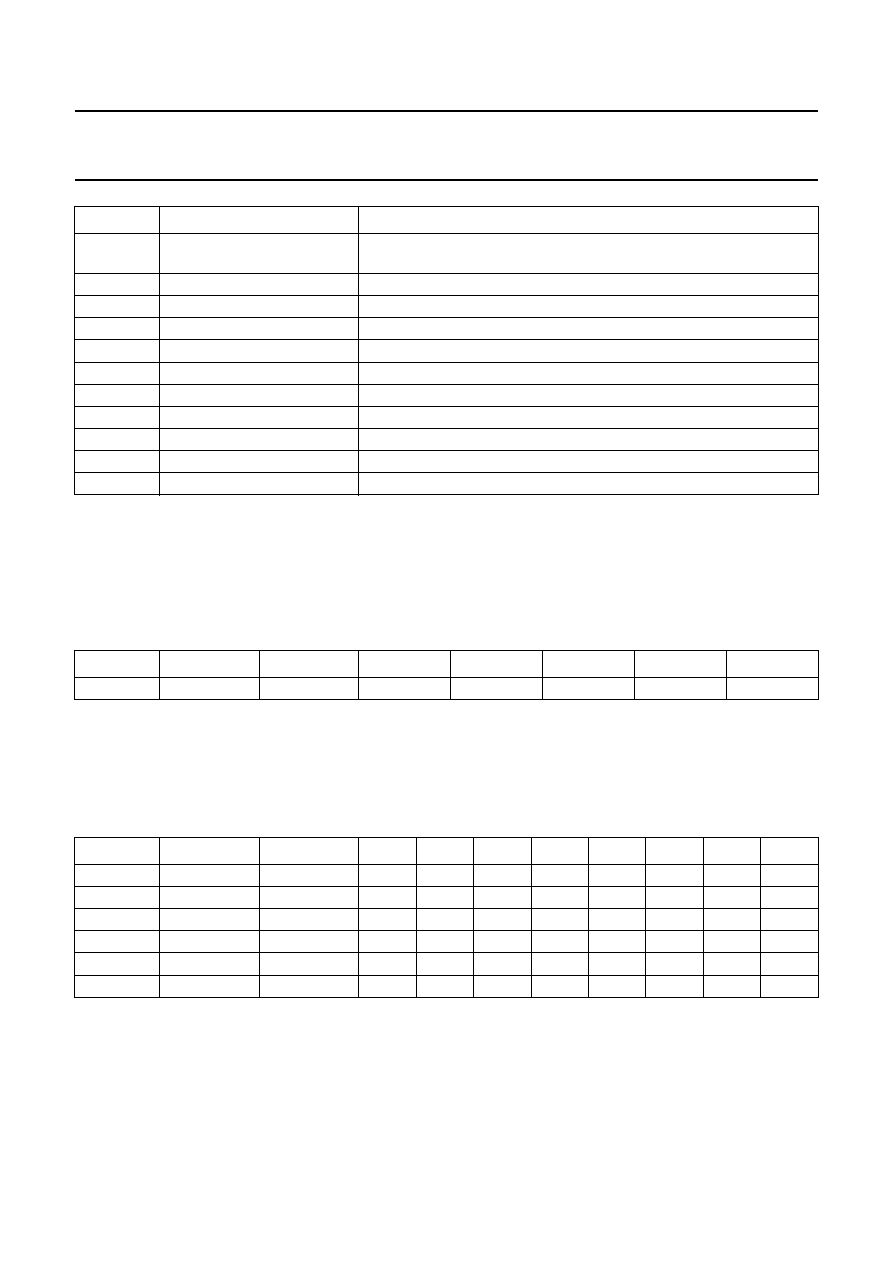
1998 Feb 16
11
Philips Semiconductors
Product specification
QIC digital equalizer
SZA1000
Control register functions
Control register functions are detailed in Tables 2 to 43.
FIR
FUNCTION
Addresses 0 to 9: FIR tap coefficient values
Table 2
Coefficient values: FIR_VAL0 to FIR_VAL9; note 1
Note
1. These are 7-bit coefficient values in two's complement notation; taps 5 to 9 are only used when R = 2; tap 10 has a
fixed coefficient value of +64.
Addresses 10 to 15: FIR tap position selection
Table 3
Tap position selection: FIR_SELnn; note 1
Note
1. See Table 4 for the value of FSn.n.
35
EQ MODE0
Mode setting for PACLK (pin 29) and GAP/STRIPE (pin 21)
(see Tables 21, 22 and 23)
36
DIFF
differentiator settings (see Tables 24, 25 and 26)
37
CLK_DIV
main clock divider (see Tables 27 and 28)
38
STRIPE_F
stripe detector nominal frequency (see Table 29)
39
EQ_MODE1
equalizer mode settings
40
PLL_FREQL
PLL nominal frequency bits 0 to 7
41
PLL_FREQH
PLL nominal frequency bits 8 to 10
42
WIN_SHIFT
PLL window shift
43
PLL_NI
PLL loop filter integrating gain and range
44
PLL_NP
PLL loop filter proportional gain
45
MLD_SET
maximum likelihood detector settings
D7
D6
D5
D4
D3
D2
D1
D0
-
FIR_VALn.6
FIR_VALn.5
FIR_VALn.4
FIR_VALn.3
FIR_VALn.2
FIR_VALn.1
FIR_VALn.0
ADDR.
NAME
TAPS
D7
D6
D5
D4
D3
D2
D1
D0
10
FIR_SEL05
0 and 5
-
-
FS0.2
FS0.1
FS0.0
FS5.2
FS5.1
FS5.0
11
FIR_SEL16
1 and 6
-
-
FS1.2
FS1.1
FS1.0
FS6.2
FS6.1
FS6.0
12
FIR_SEL27
2 and 7
-
-
FS2.2
FS2.1
FS2.0
FS7.2
FS7.1
FS7.0
13
FIR_SEL38
3 and 8
-
-
FS3.2
FS3.1
FS3.0
FS8.2
FS8.1
FS8.0
14
FIR_SEL49
4 and 9
-
-
FS4.2
FS4.1
FS4.0
FS9.2
FS9.1
FS9.0
15
FIR_SEL10
10
-
-
-
-
FS10.3 FS10.2 FS10.1 FS10.0
ADDRESS
NAME
DESCRIPTION
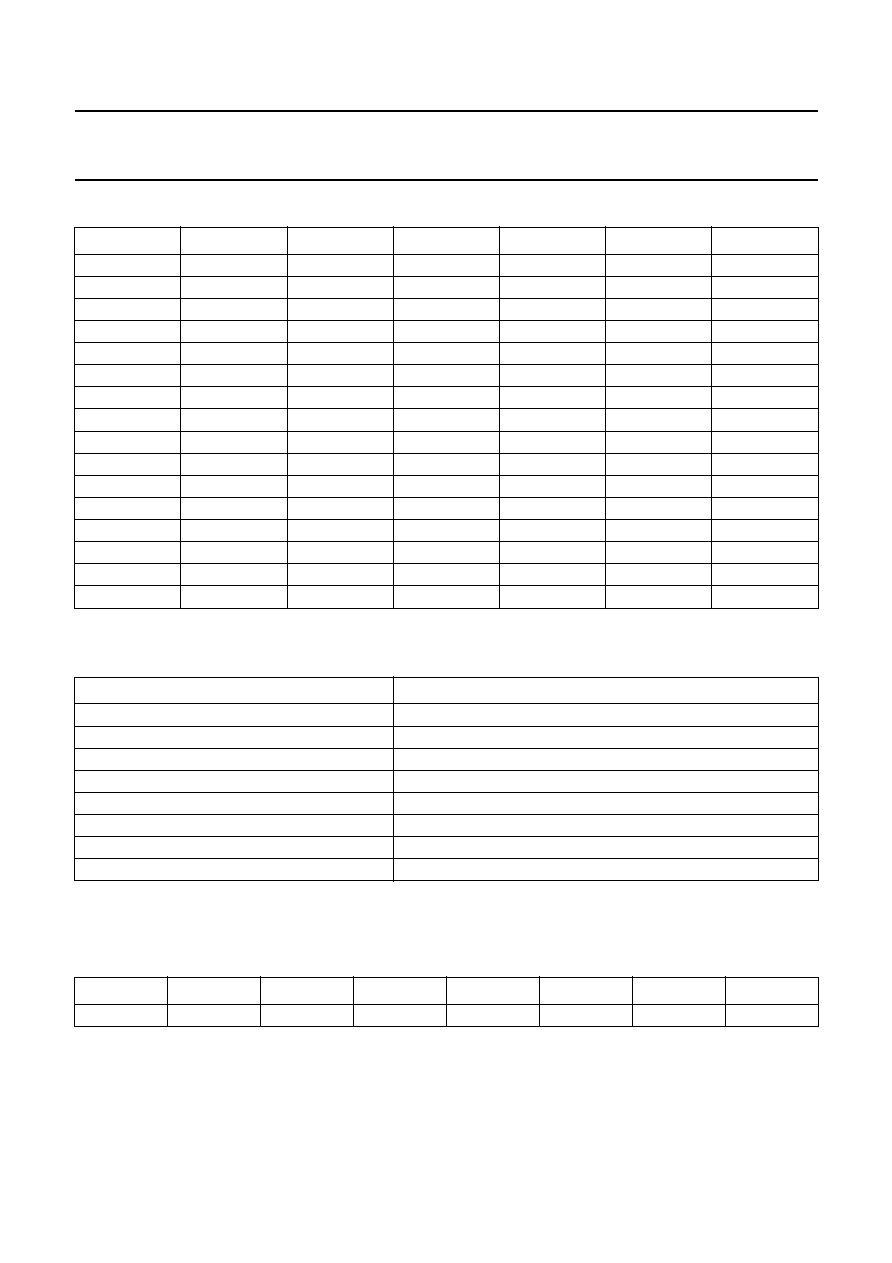
1998 Feb 16
12
Philips Semiconductors
Product specification
QIC digital equalizer
SZA1000
Table 4
Translation table: FS selection bits (FSn.n from Table 3) to tap position
Address 16: FIR output scaling
Table 5
Output scaling: FIR_SHIFT
L
OW
-
PASS FILTER FUNCTIONS
Addresses 17 to 22: LPF tap coefficient values
Table 6
Coefficient value: LPF_VAL1 to LPF_VAL6; notes 1 and 2
Notes
1. These are 8-bit coefficient values in two's complement notation; taps 4 to 6 are only used when R = 2.
2. See Table 7 for the values of LPF_VALn.n
FSn
TAP 0,5
TAP 1,6
TAP 2,7
TAP 3,8
TAP 4,9
TAP 10
0
12
9
6
3
0
2
1
13
10
7
4
1
3
2
14
11
8
5
2
4
3
15
12
9
6
3
5
4
16
13
10
7
4
6
5
17
14
11
8
5
7
6
18
15
12
9
6
8
7
19
16
13
10
7
9
8
-
-
-
-
-
10
9
-
-
-
-
-
11
10
-
-
-
-
-
12
11
-
-
-
-
-
13
12
-
-
-
-
-
14
13
-
-
-
-
-
15
14
-
-
-
-
-
16
15
-
-
-
-
-
17
FIR_SHIFT (BINARY)
FIR OUTPUT SCALING GAIN FACTOR
00000001
1
00000010
2
00000100
4
00001000
8
00010000
16
00100000
32
01000000
64
10000000
128
D7
D6
D5
D4
D3
D2
D1
D0
LPF_VALn.7
LPF_VALn.6
LPF_VALn.5
LPF_VALn.4
LPF_VALn.3
LPF_VALn.2
LPF_VALn.1
LPF_VALn.0
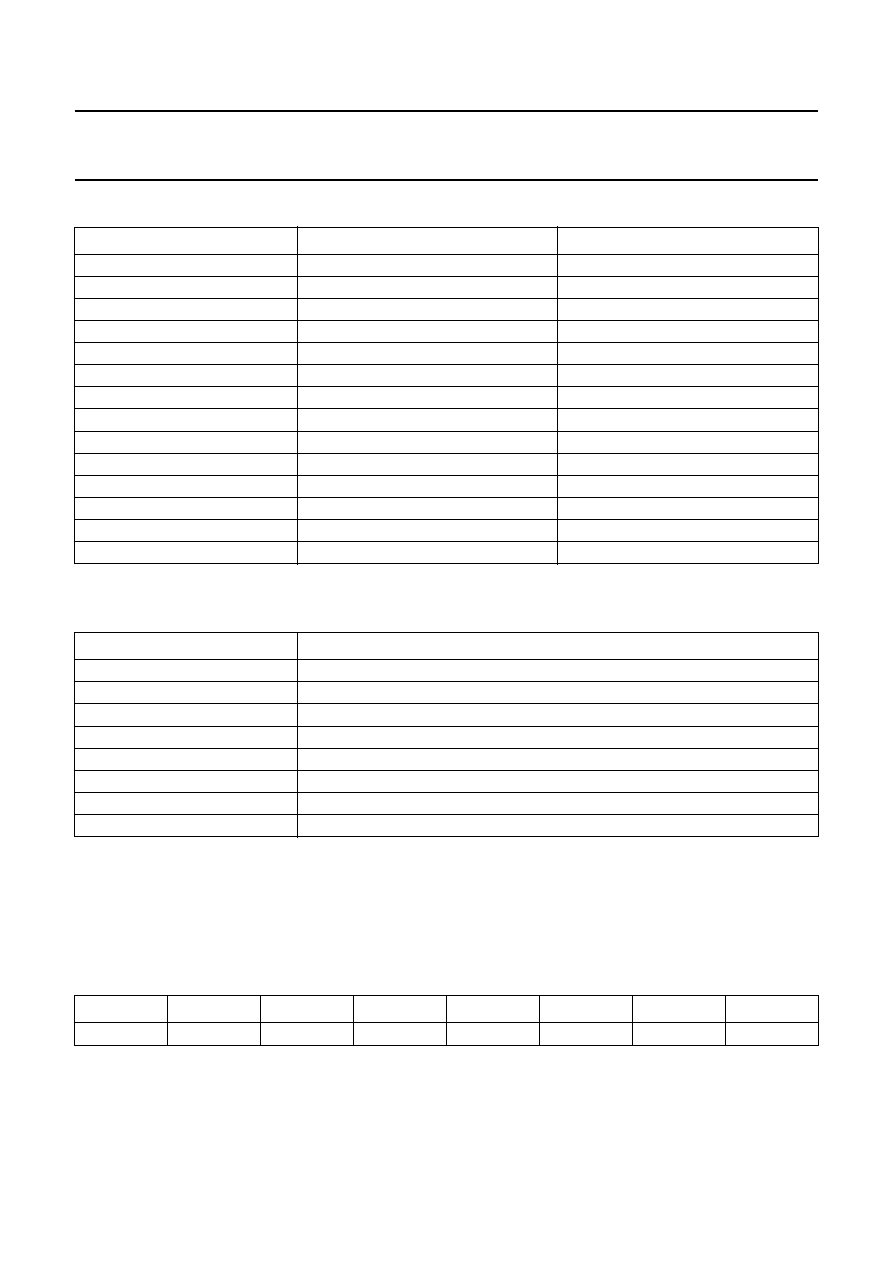
1998 Feb 16
13
Philips Semiconductors
Product specification
QIC digital equalizer
SZA1000
Table 7
LPF tap positions
Address 23: LPF output scaling
Table 8
Output scaling: LPF_SHIFT
A
MPLITUDE QUALIFIER
/
DETECTOR FUNCTIONS
Address 24: QUAL_FIX_POS and Address 25: QUAL_FIX_NEG
QUAL_FIX_POS and QUAL_FIX_NEG contain the positive and negative fixed threshold (8-bit signed) values.
Address 26: Variable gain factors
Table 9
Gain factors: QUAL_VAR_GAIN; note 1
Note
1. GP and GN set the factors of the measured amplitude that are to be used as variable qualifier thresholds: GP for the
positive peaks and GN for the negative peaks.
TAP POSITION
COEFFICIENT VALUES R = 1
COEFFICIENT VALUES R = 2
0
LPF_VAL3
LPF_VAL6
1
LPF_VAL2
LPF_VAL5
2
LPF_VAL1
LPF_VAL4
3
+128
LPF_VAL3
4
+128
LPF_VAL2
5
LPF_VAL1
LPF_VAL1
6
LPF_VAL2
+128
7
LPF_VAL3
+128
8
0
LPF_VAL1
9
0
LPF_VAL2
10
0
LPF_VAL3
11
0
LPF_VAL4
12
0
LPF_VAL5
13
0
LPF_VAL6
LPF_SHIFT (BINARY)
LPF OUTPUT SCALING GAIN FACTOR
00000001
1
00000010
2
00000100
4
00001000
8
00010000
16
00100000
32
01000000
64
10000000
128
D7
D6
D5
D4
D3
D2
D1
D0
-
-
GP.2
GP.1
GP.0
GN.2
GN.1
GN.0
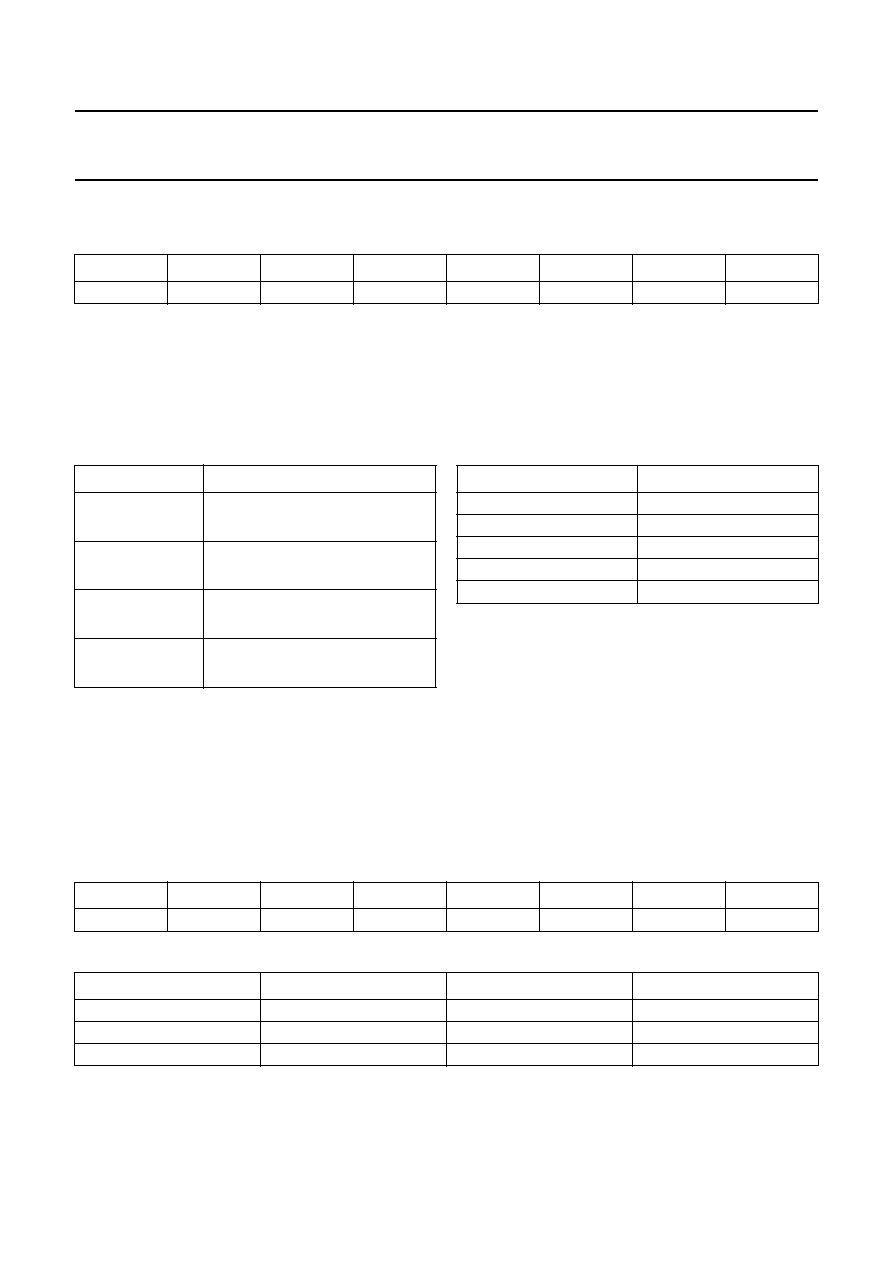
1998 Feb 16
14
Philips Semiconductors
Product specification
QIC digital equalizer
SZA1000
Address 27: Amplitude detector slope qualification delay
Table 10 Qualification delay: QUAL_SLOPE_DEL; notes 1 and 2
Notes
1. DEL is the programmable compensation delay, in cycles of f
s
, between the qualifier and the analog zero crossing of
the read pulse circuit; DEL is a 2-bit unsigned value
2. SL selects the decay time of the amplitude detectors.
D7
D6
D5
D4
D3
D2
D1
D0
-
-
-
-
DEL.1
DEL.0
SL.1
SL.0
Table 11 Amplitude detector decay time
SL
DECAY TIME
0
1
2
3
500
f
s
----------
500
f
s
----------
1000
f
s
-------------
2000
f
s
-------------
4000
f
s
-------------
Table 12 Variable qualifier threshold
GP, GN
VARIABLE THRESHOLD
0
0
1
1
/
8
2
1
/
4
3
3
/
8
4, 5, 6, 7
1
/
2
G
AP DETECTOR FUNCTIONS
Address 28: Fixed threshold: GAP_THRESH
Fixed threshold for the gap detector; 8-bit signed value.
W
RITE
E
QUALIZATION
(WEQ)
FUNCTIONS
Address 29: WEQ settings
Table 13 Time slots: WEQ_SET0; see Table 14
Table 14 Time slots in channel bit cell
D7
D6
D5
D4
D3
D2
D1
D0
-
-
-
-
-
N6
N3
N2
NUMBER OF TIME SLOTS
N6
N3
N2
2
0
0
1
3
0
1
0
6
1
0
0

1998 Feb 16
15
Philips Semiconductors
Product specification
QIC digital equalizer
SZA1000
Address 30: WEQ settings
Table 15 WEQ_SET1; notes 1 to 4, see also Tables 16 and 17.
Notes
1. If bit WDI_O is HIGH, the circuit output is a WD signal, else a WDI signal.
2. If bit WDI_I is HIGH, the circuit expects a WD signal at the input, else a WDI signal.
3. If the RESYNC bit is HIGH, the WEQ circuit resynchronizes its time buffer during a gap in the QIC 3010 or QIC 3020
format; this setting is only permitted if 6 time slots in a bit-cell are selected (N6 = 1; see Table 14).
4. TPS sets the position of the inserted write equalization pulse, TWS sets its width.
D7
D6
D5
D4
D3
D2
D1
D0
WDI_O
WDI_I
RESYNC
TPS2
TPS1
TPS0
TWS1
TWS0
Fig.6 WD/WDI signal timing.
handbook, halfpage
MGG586
WD
WDI
Fig.7 Position and width of write equalization pulse.
handbook, halfpage
MGG587
td
tw
1 T
1.5 T
2 T, etc. to 4 T
1
0
1
1
0
1
1
0
0
0
0
1
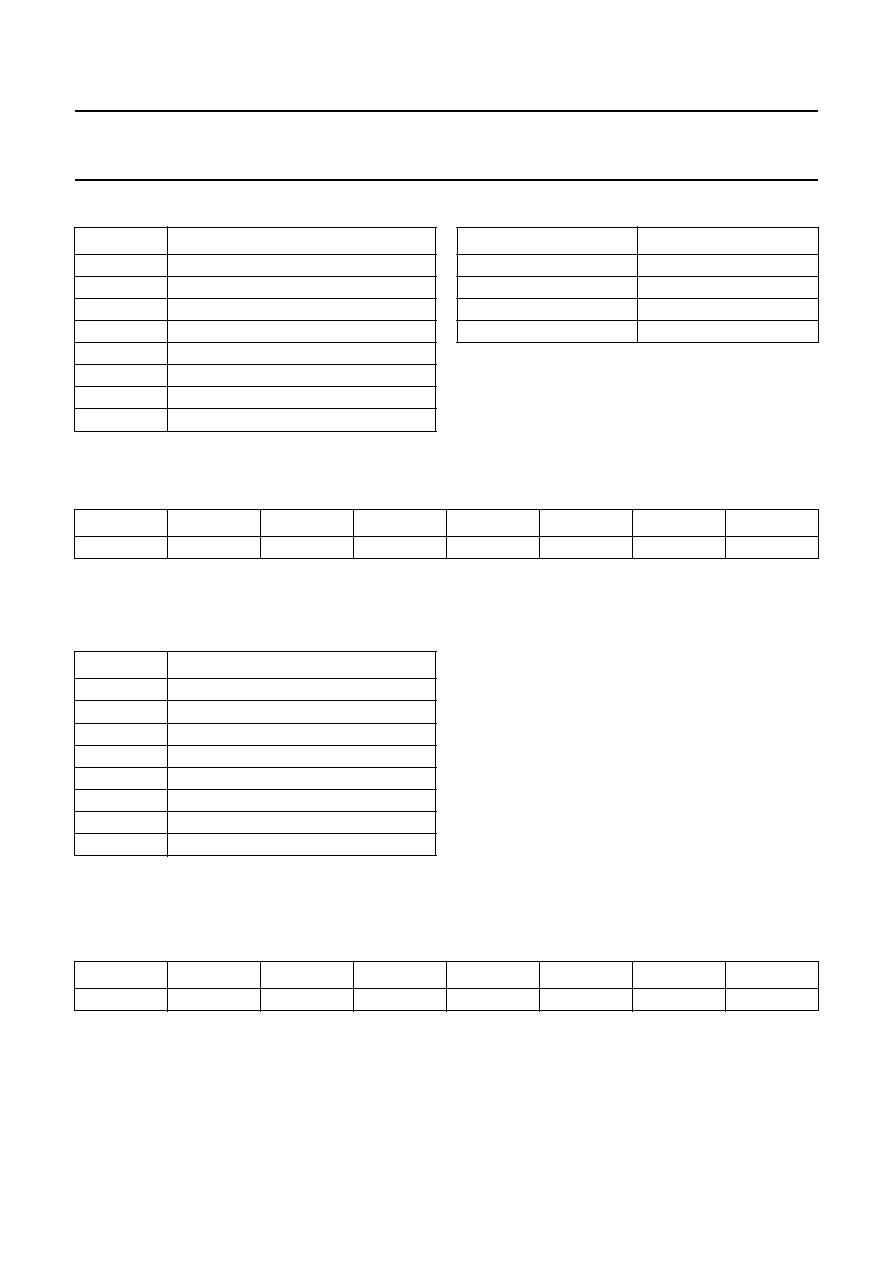
1998 Feb 16
16
Philips Semiconductors
Product specification
QIC digital equalizer
SZA1000
Table 16 Write equalization pulse position
TPS
POSITION IN TIME SLOTS
0
1
1
2
2
3
3
4
4
5
5
6
6
7
7
8
Table 17 Write equalization pulse width
TWS
WIDTH IN TIME SLOTS
0
WEQ off
1
1
2
2
3
3
Address 31: WEQ circuit clock divider
Table 18 Division factor: WEQ_CLK_DIV; note 1
Note
1. WCD sets the division factor between WEQCLK and the frequency of the time slot.
D7
D6
D5
D4
D3
D2
D1
D0
-
-
-
-
-
WCD.2
WCD.1
WCD.0
Table 19 WEQ clock division
WCD
WEQ CLOCK DIVISION FACTOR
0
1
1
2
2
3
3
4
4
5
5
6
6
7
7
8
U
NCOMMITTED CURRENT
DAC
FUNCTIONS
Addresses 33 and 34: Current DACs
Table 20 DAC current: IDAC1 and IDAC2; note 1
Note
1. These are 5-bit unsigned numbers; the DAC current is
mA.
D7
D6
D5
D4
D3
D2
D1
D0
-
-
-
IDn.4
IDn.3
IDn.2
IDn.1
IDn.0
IDn
16
----------
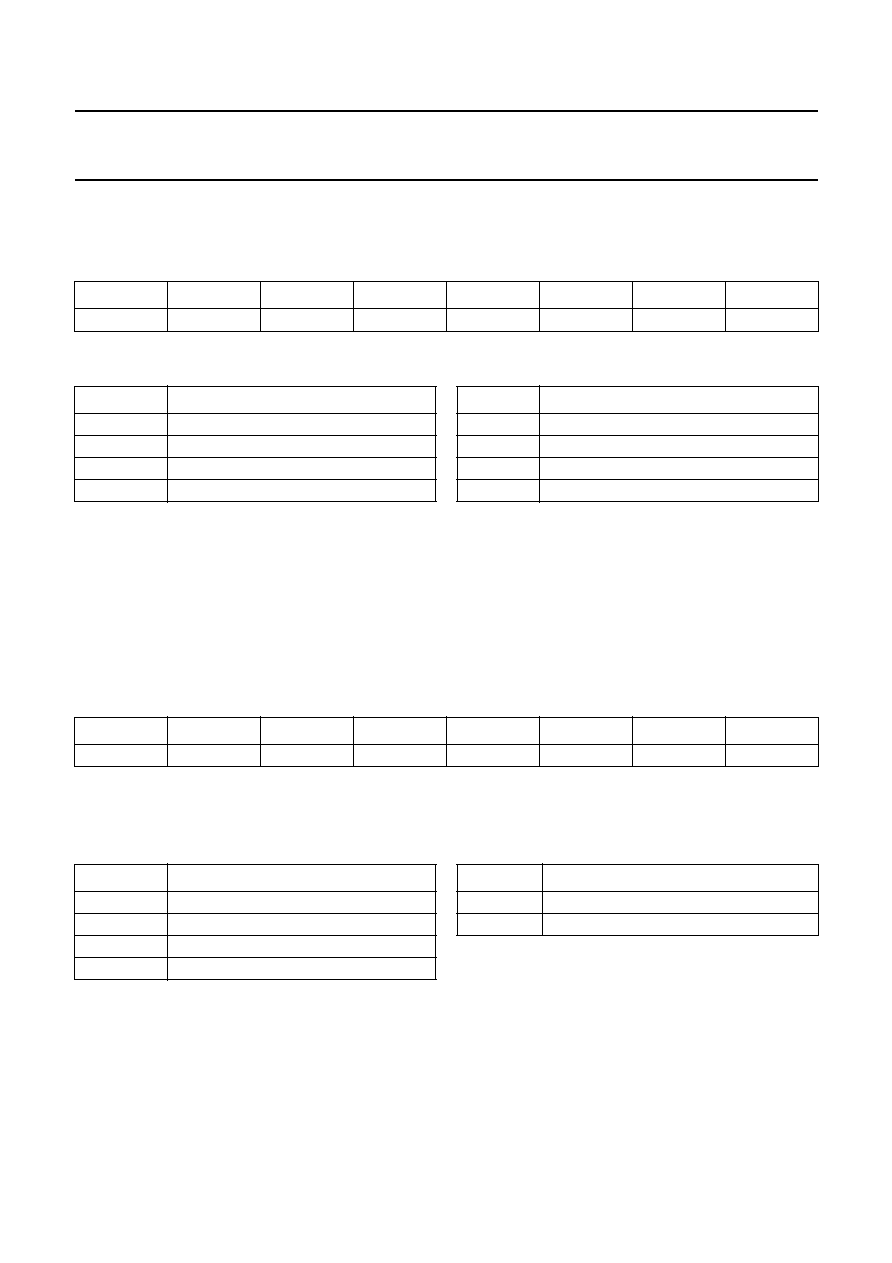
1998 Feb 16
17
Philips Semiconductors
Product specification
QIC digital equalizer
SZA1000
O/P
SIGNAL FUNCTION
:
PINS
21
AND
29
Address 35: O/P Select pins 21 and 29
Table 21 Output signal select: EQ MODE 0; see Tables 22 and 23
D7
D6
D5
D4
D3
D2
D1
D0
-
-
-
-
PA.1
PA.0
GAP.1
GAP.0
Table 22 Output signal: pin 21
Notes
1. GAP, STRIPE or QUAL may be selected to detect
gaps, stripes or valid signal peaks. All are active HIGH.
2. See also Table 34.
3. The RD output (read pulse): falling edge active.
GAP
OUTPUT SIGNAL ON PIN 21
0
GAP
(1)
1
STRIPE
2
QUAL
(2)
3
RD
(3)
Table 23 Output signal: pin 29
PA
OUTPUT SIGNAL ON PIN 29
0
f
s
- PACLK on
1
1 - PACLK off
2
0 - PACLK off
3
0 - PACLK off
D
IFFERENTIATOR FUNCTIONS
Address 36: Differentiator settings
Table 24 DIFF; note 1
Note
1. DL1 and DL2 are programmable delays for the differentiator; DS is the gain factor of the differentiated signal.
D7
D6
D5
D4
D3
D2
D1
D0
-
-
-
DS
DL2.1
DL2.0
DL1.1
DL1.0
Table 25 Differentiator delay; notes 1 and 2
Notes
1. DL1 and DL2 are added to provide a maximum delay
of 6
◊
f
s
cycles.
2. It is advisable to have DL1 and DL2 equal to avoid
adding unwanted delay in the differentiator.
DLn
DELAY IN f
s
CYCLES
0
0
1
1
2
2
3
3
Table 26 Differentiator gain factor
DS
OUTPUT SCALING GAIN FACTOR
0
4
1
2
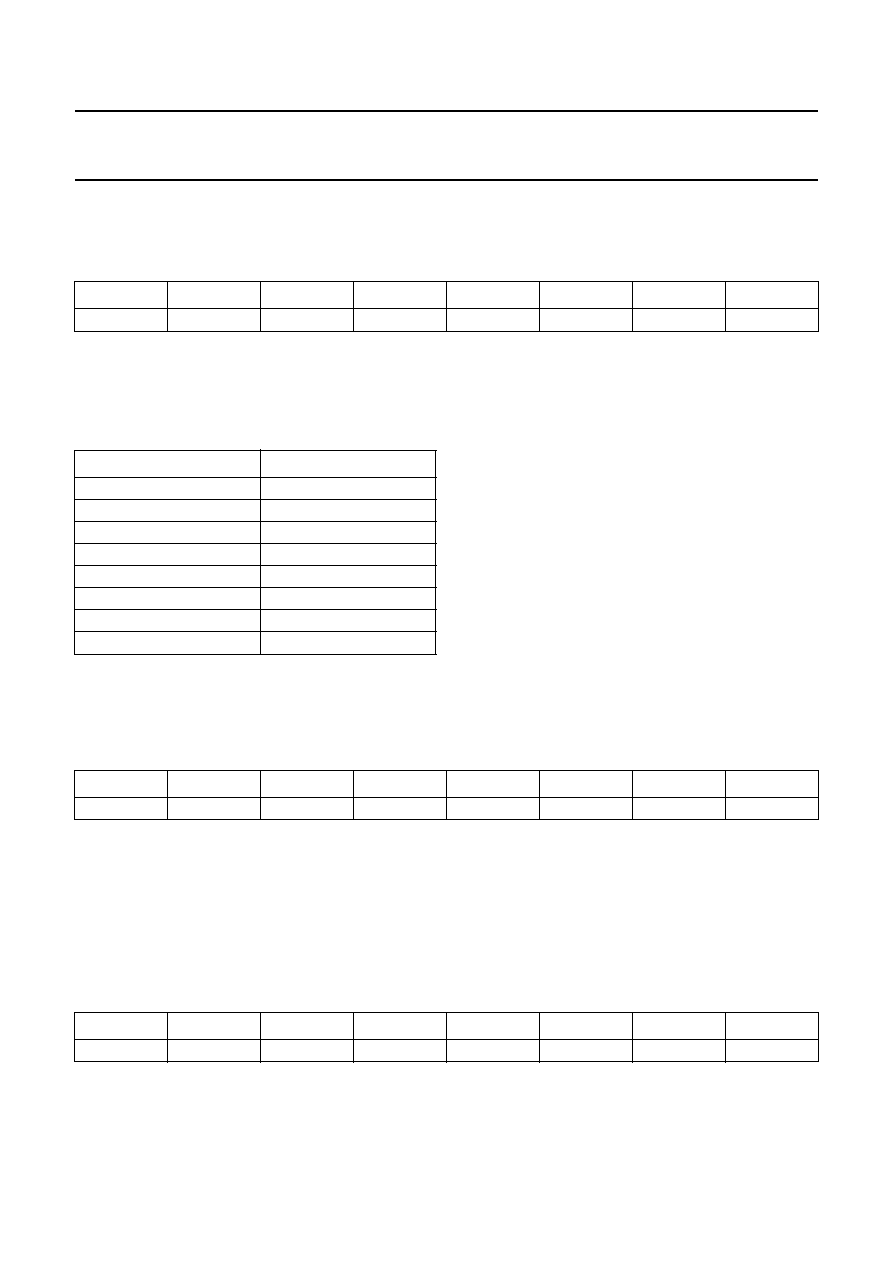
1998 Feb 16
18
Philips Semiconductors
Product specification
QIC digital equalizer
SZA1000
C
LOCK FUNCTIONS
Address 37: Main clock divider
Table 27 Clock divider: CLK_DIV; note 1
Note
1. CD selects the main clock division factor. The CLKIN frequency (pin 6) divided by this factor gives the IC's operating
frequency f
s
(apart from the WEQ circuit).
D7
D6
D5
D4
D3
D2
D1
D0
-
-
-
-
-
CD.2
CD.1
CD.0
Table 28 Clock division factor
CD
CLOCK DIVISION
0
1
1
2
2
3
3
4
4
5
5
6
6
7
7
8
S
TRIPE DETECTOR FUNCTIONS
Address 38: Stripe detector nominal frequency
Table 29 Qualification threshold: STRIPE_F; note 1
Note
1. SF is an unsigned 5-bit value used to determine the detection threshold for the stripe detector. The nominal detection
frequency is
AUXBUS,
PINS
25
AND
27,
SAMPLE RATE REDUCTION AND STAND
-
BY FUNCTIONS
Address 39: Equalizer mode settings
Table 30 EQ_MODE 1; note 1, see also Tables 31 to 34
Note
1. R1 selects the filter sample rate reduction factor; STBY1 and STBY2 are the DAC and ADC power on/off switches;
ST selects output signal modes for pins 25 and 27.
D7
D6
D5
D4
D3
D2
D1
D0
-
-
-
SF.4
SF.3
SF.2
SF.1
SF.0
D7
D6
D5
D4
D3
D2
D1
D0
-
STBY2
ST.3
ST.2
ST.1
ST.0
STBY1
R1
f
s
3
SF
1
+
(
)
◊
----------------------------------
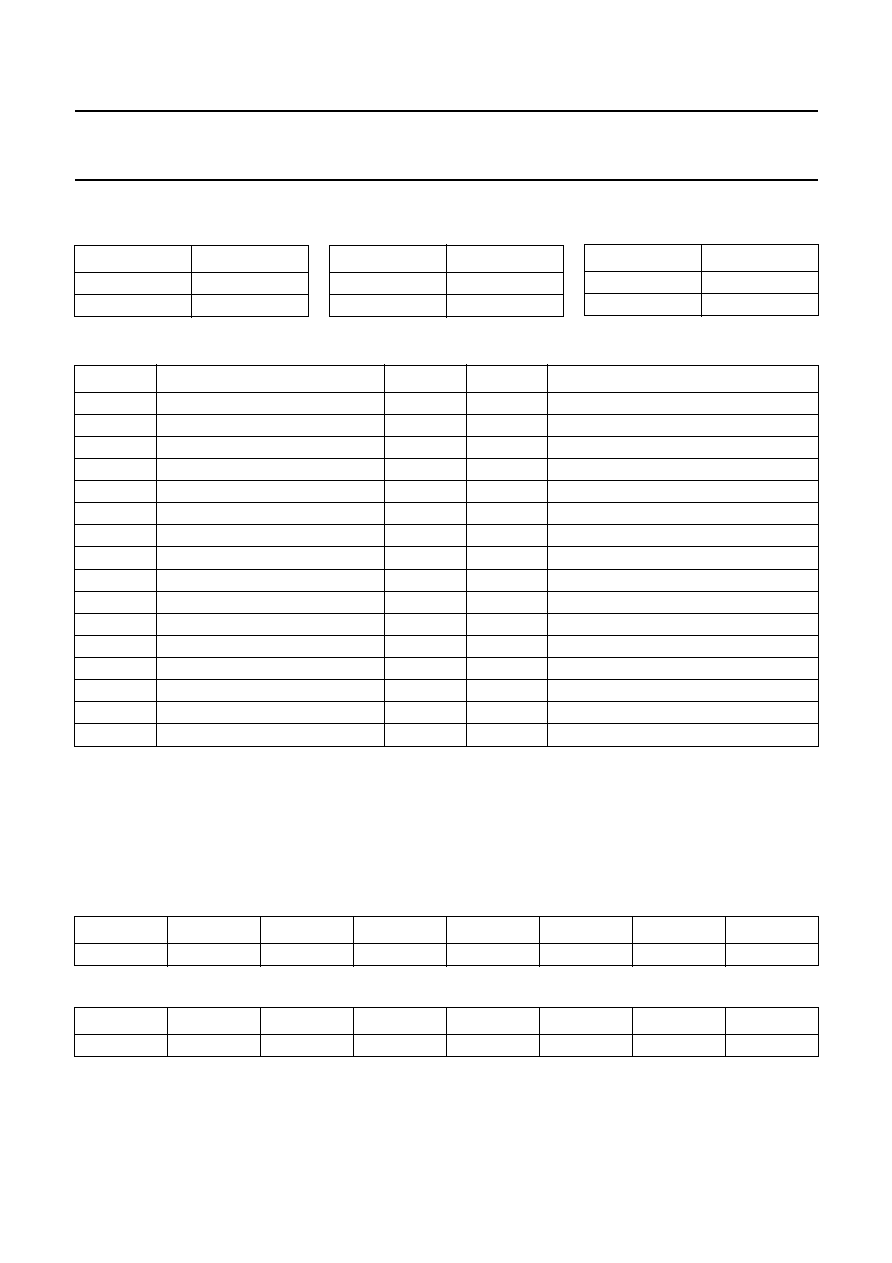
1998 Feb 16
19
Philips Semiconductors
Product specification
QIC digital equalizer
SZA1000
Table 31 FIR/LPF Sample Rate
Reduction Factor: R
R1
R
0
2
1
1
Table 32 DAC power
STBY1
D/A POWER
0
on
1
off
Table 33 ADC power
STBY2
A/D POWER
0
on
1
off
Table 34 Mode settings: pins 25, 27 and AUXBUS
Notes
1. QUAL is a test signal (active HIGH) used to detect valid signal peaks (see also Table 22).
2. When COMP is selected, pin 25 is switched to the output of the read pulse circuit comparator for test purposes.
PLL
FUNCTIONS
Addresses 40 and 41: PLL nominal frequency
Table 35 PLL_FREQL (address 40)
Table 36 PLL_FREQH (address 41); note 1
Note
1. The nominal PLL frequency is
ST
IC MODE
PIN 27
PIN 25
AUXBUS
0
PLL off
RD
QUAL
(1)
bit 0: WDOUT, bits 1 to 7 high-Z
1
PLL off
RD
COMP
(2)
bit 0: WDOUT, bits 1 to 7 high-Z
2
PLL on
SRD
RRC
bit 0: WDOUT, bits 1 to 7 high-Z
3
ADC test
SRD
RRC
ADC output
4
DAC test
RD
COMP
DAC output
5
one shot test
-
-
-
6
PLL off, AD bypass
RD
QUAL
8-bit input to HPF
7
PLL off, AD bypass
RD
COMP
8-bit input to HPF
8
PLL on, AD bypass
SRD
RRC
8-bit input to HPF
9
PLL on, LPF output
SRD
RRC
LPF output after scaling
10
PLL on, FIR output
SRD
RRC
FIR output after scaling and interpolator
11
PLL on, PLL phase output
SRD
RRC
PLL phase error output
12
PLL on, PLL frequency output
SRD
RRC
PLL frequency output
13
PLL on, peak-to-peak level output
SRD
RRC
bits 7 to 1: LEVEL_ABS; bit 0:WDOUT
14
PLL on, filtered level output
SRD
RRC
bits 7 to 1: LEVEL_FIL; bit 0:WDOUT
15
PLL on, differentiator output
SRD
RRC
differentiator output after scaling
D7
D6
D5
D4
D3
D2
D1
D0
PF.7
PF.6
PF.5
PF.4
PF.3
PF.2
PF.1
PF.0
D7
D6
D5
D4
D3
D2
D1
D0
-
-
-
-
-
PF.10
PF.9
PF.8
f
s
PF
2048
-------------
◊
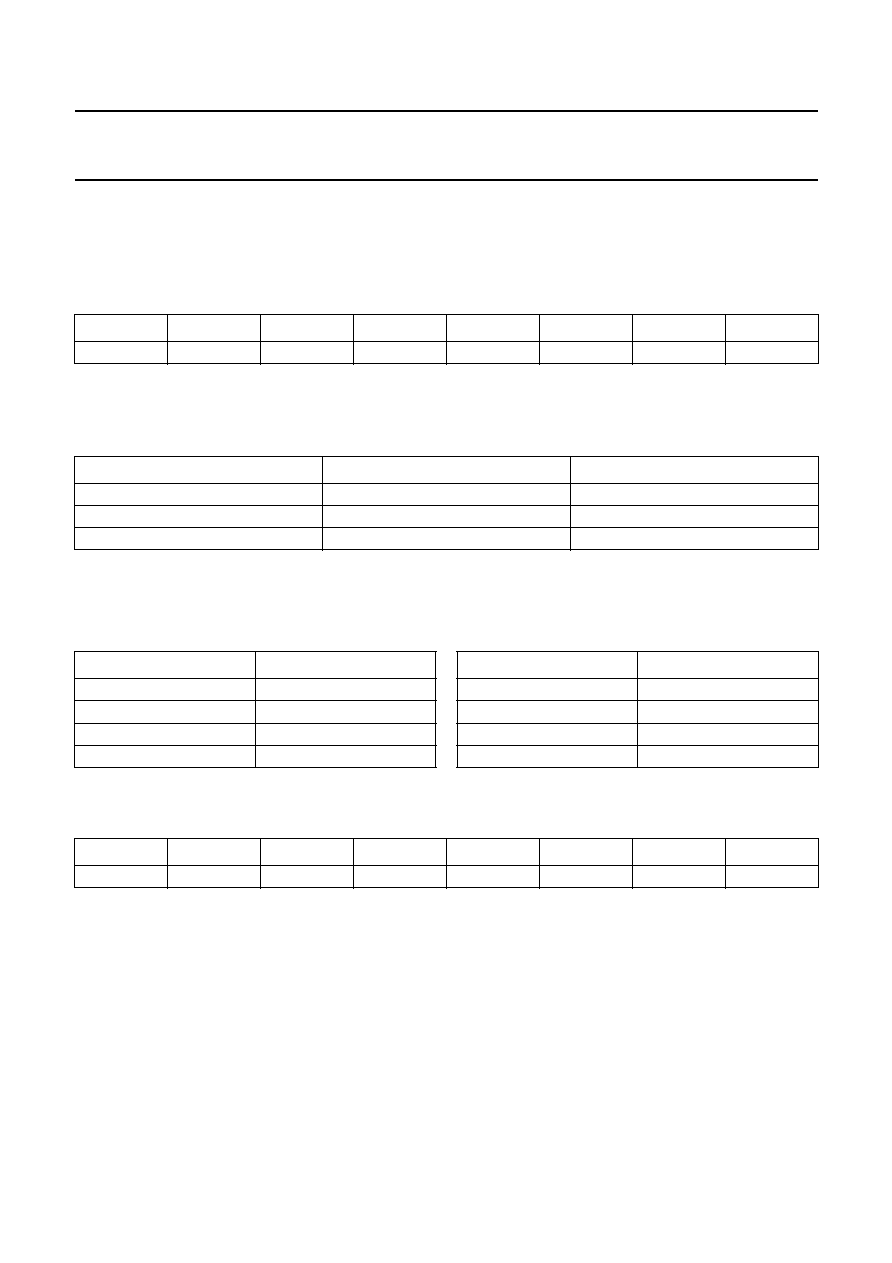
1998 Feb 16
20
Philips Semiconductors
Product specification
QIC digital equalizer
SZA1000
Address 42: Phase comparator window shift
WIN_SHIFT is an 8-bit number in two's complement format. The programmed phase shift is 180
◊
WIN_SHIFT degrees.
Address 43: PLL settings
Table 37 Address 43: PLL_NI; note 1
Note
1. If LTD (pin 19) is HIGH, NI2 is selected, else NI1.
Table 38 DL setting; note 1
Note
1. The Differentiator Delay (DL) settings (see Table 25) determine the values of Q1 and Q0 that should be entered.
D7
D6
D5
D4
D3
D2
D1
D0
Q1
Q0
RNG.1
RNG.0
NI2.1
NI2.0
NI1.1
NI1.0
DL SETTING
Q1
Q0
DL1 = DL2
1
1
DL1 < DL2
1
0
DL1 > DL2
0
1
Table 39 Integrating gain factor KI
NI
KI
0
1
/
64
1
1
/
128
2
1
/
256
3
1
/
512
Table 40 PLL range
RNG
PLL RANGE
0
±
64
1
±
128
2
±
256
3
±
512
Address 44: PLL loop filter proportional gain
Table 41 PLL_NP; note 1
Note
1. If LTD (pin 19) is HIGH, NP2 is selected, else NP1.
D7
D6
D5
D4
D3
D2
D1
D0
-
-
NP2.2
NP2.1
NP2.0
NP1.2
NP1. 1
NP1. 0
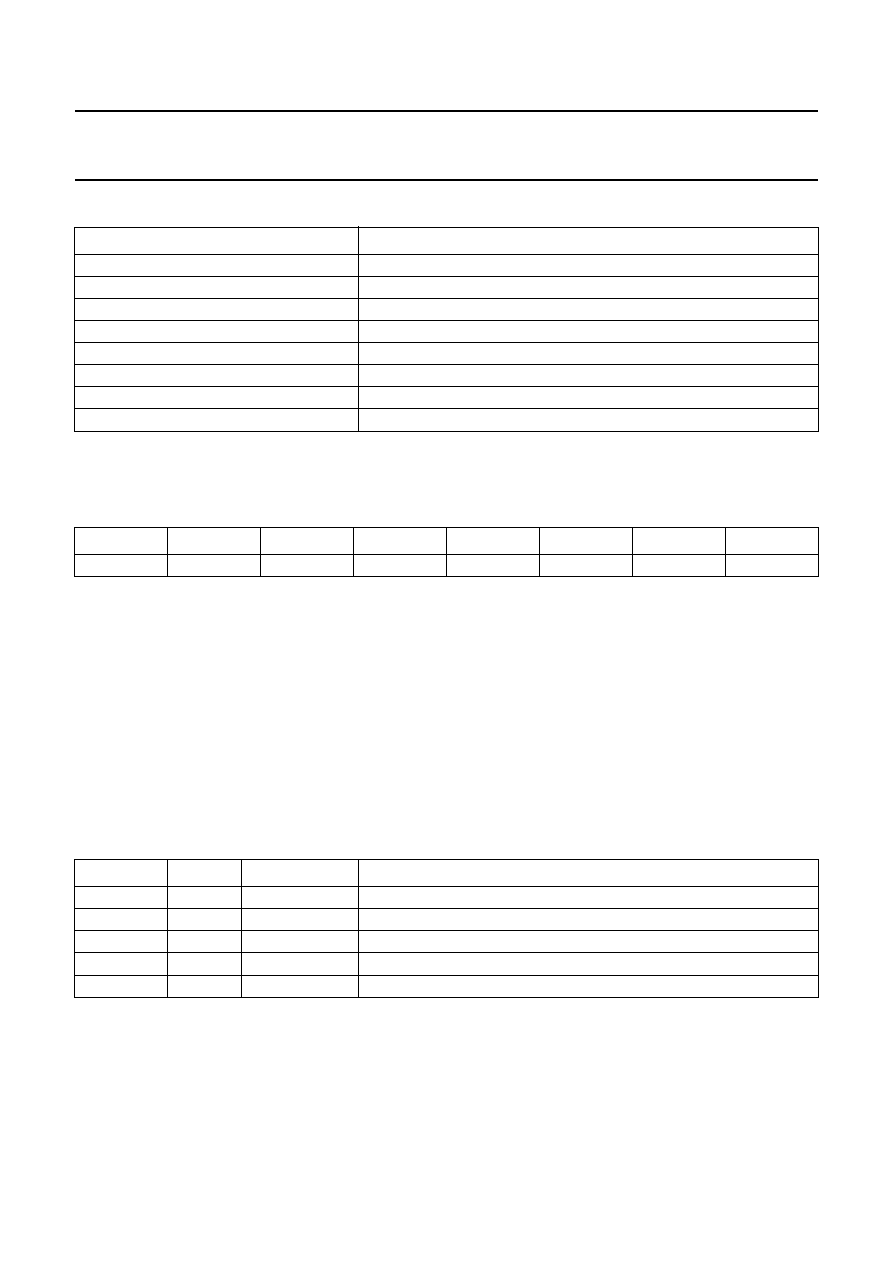
1998 Feb 16
21
Philips Semiconductors
Product specification
QIC digital equalizer
SZA1000
Table 42 Proportional gain factor KP
M
AXIMUM LIKELIHOOD DETECTOR FUNCTIONS
Address 45: Settings
Table 43 Address 45: MLD_SET
Notes
1. Check for k constraint: k is the maximum number of channel bit-cells allowed without a transition. For MFM code:
k = 3 (ks = 4), for RLL(1,7) code: k = 7 (ks = 8).
2. Check for d = 1 constraint: d is the minimum number of channel bit-cells without transitions that must come between
two bit cells with transitions. d = 1 for both MFM and RLL(1,7) codes
3. Check partial response constraints; delete incorrect peaks.
4. Check partial response constraints; add missing peaks.
5. ks = k + 1.
S
TATUS REGISTER
The status register contains 5 status bytes. The contents of the status bytes can be read via the serial interface.
Table 44 Status bytes; notes 1 to 4
Notes
1. The levels are measured behind the re-sampling block (interpolator) (see Fig.1).
2. Actual PLL frequency is an 8-bit unsigned number:
3. LEVEL_FIL can be used for reading of the burst levels, or in an AGC loop (with the TZA1000 preamplifier).
4. LEVEL_POS, LEVEL_NEG, LEVEL_ABS and LEVEL_FIL are 8-bit numbers in two's complement format.
NP
KP
0
1
1
1
/
2
2
1
/
4
3
1
/
8
4
1
/
16
5
1
/
32
6
-
7
-
D7
D6
D5
D4
D3
D2
D1
D0
en_k
(1)
en_d
(2)
PR1
(3)
PR0
(4)
ks3
(5)
ks2
(5)
ks1
(5)
ks0
(5)
ADDRESS
DATA
NAME
DESCRIPTION
255
0
FREQ
actual frequency of PLL
255
1
LEVEL_POS
positive peaks in measured level
255
2
LEVEL_NEG
negative peaks in measured level
255
3
LEVEL_ABS
measured peak-to-peak level
255
4
LEVEL_FIL
low-pass filtered LEVEL_ABS
f
s
FREQ
256
------------------
◊

1998 Feb 16
22
Philips Semiconductors
Product specification
QIC digital equalizer
SZA1000
LIMITING VALUES
In accordance with the Absolute Maximum Rating System (IEC 134).
Notes
1. Equivalent to discharging a 100 pF capacitor through a 1.5 k
series resistance.
2. Equivalent to discharging a 200 pF capacitor through a 25
series resistance and a 2.5
µ
H series inductance.
THERMAL CHARACTERISTICS
QUALITY SPECIFICATION
In accordance with
"SNW-FQ-611-E".
SYMBOL
PARAMETER
CONDITIONS
MIN.
MAX.
UNIT
V
DDD1
digital supply voltage
-
0.3
+5.5
V
V
DDD2
digital supply voltage
-
0.3
+5.5
V
V
DDA1
analog supply voltage
-
0.3
+5.5
V
V
DDA2
analog supply voltage
-
0.3
+5.5
V
V
i
input voltage
-
0.3
V
DD
+ 0.3 V
I
I
input current on supply pins
-
50
+50
mA
I
I(n)
input current on remaining pins
-
10
+10
mA
P
tot
maximum total power dissipation
-
+1100
mW
T
amb
ambient temperature
-
30
+85
∞
C
T
j
junction temperature
-
30
+125
∞
C
T
stg
storage temperature
-
50
+150
∞
C
V
ES(HB)
electrostatic handling: human body model
note 1
-
3000
+3000
V
V
ES(MM)
electrostatic handling: machine model
note 2
-
300
+300
V
SYMBOL
PARAMETER
CONDITIONS
VALUE
UNIT
R
th(j-a)
thermal resistance from junction to ambient
in free air
70
K/W

1998 Feb 16
23
Philips Semiconductors
Product specification
QIC digital equalizer
SZA1000
CHARACTERISTICS
V
DDD1
= V
DDD2
= V
DDA1
= V
DDA2
= 5 V
±
5%; f
s
= f
clk(CLKIN)
= 24 MHz; V
ref
= 2 V
±
5%; R
ref
= 10 k
, unless otherwise
specified
.
SYMBOL
PARAMETER
CONDITIONS
MIN.
TYP.
MAX.
UNIT
V
DDD1
digital supply voltage
4.5
5.0
5.5
V
V
DDD2
digital supply voltage
4.5
5.0
5.5
V
V
DDA1
analog supply voltage
4.5
5.0
5.5
V
V
DDA2
analog supply voltage
4.5
5.0
5.5
V
I
DDD1
; I
DDD2
digital supply current
r = 2, no WEQ
-
32
80
mA
I
DDA1
; I
DDA2
analog supply current
STBY1 = 0;
STBY2 = 1;
see Table 30
-
50
65
mA
STBY 1= 1;
STBY2 = 0
-
26
35
mA
f
clk(CLKIN)
read circuit clock frequency
-
24
24
MHz
f
clk(WEQCLK)
WEQ circuit clock frequency
N6 = 0;
see Table 14;
(3080; 3095)
-
-
36
MHz
V
IL
LOW-level input voltage
-
-
0.3V
DD
V
V
IH
HIGH-level input voltage
0.7V
DD
-
-
V
V
OL
LOW-level output voltage
I
o
=
-
4 mA
-
-
0.5
V
V
OH
HIGH-level output voltage
I
o
= +4 mA
V
DD
-
0.5
-
-
V
C
i
input capacitance
I/O pins high-Z;
note 1
-
-
5
pF
Analog section
V
ref
reference voltage (pin 37)
1.8
2.0
2.2
V
I
ref
reference current (pin 37)
1.0
1.7
2.1
mA
V
cnv(A/D)
A/D conversion range
-
1.6
-
V
V
CM(A/D)
A/D common mode voltage
2
2.5
3
V
R
i(A/D)
A/D input resistance
2.3
3.3
4.4
k
C
i(A/D)
A/D input capacitance
-
3
5
pF
I
I(32)
DC input current (INA)
-
0.42
0.6
mA
I
I(33)
DC input current (INB)
-
0.13
0.2
mA
V
38
voltage on pin 38 (R
ref
)
-
2.0
-
V
I
O(1)
output current on pin 1 (IO1)
IDAC1 = 0;
see Table 20
-
0.0
0.05
mA
IDAC1 = 31
1.40
1.95
2.60
mA
I
O(2)
output current on pin 2 (IO2)
IDAC2 = 0;
see Table 20
-
0.0
0.05
mA
IDAC2 = 31
1.40
1.95
2.60
mA
V
o(dif)
D/A differential output range
(peak-to-peak)
note 2
1.5
1.72
1.8
V
V
CM(D/A)
D/A common mode voltage
note 2
1.0
1.16
1.4
V

1998 Feb 16
24
Philips Semiconductors
Product specification
QIC digital equalizer
SZA1000
f
-
3dB(cutoff)(LPF)
-
3dB cut-off frequency,
analog LPF (DAC filter)
note 2
-
8
-
MHz
V
CM(COMP)
comparator common mode
voltage
note 3
1.0
1.16
1.4
V
R
i(COMP)
comparator input resistance
note 4
17
26
35
k
V
IO(COMP)
comparator offset voltage
note 4
-
-
45
mV
Serial interface
f
clk(SIO)
serial i/f clock
-
-
1
/
4
f
s
MHz
t
su(D-CLK)
set-up time: data-to-clock
10
-
-
ns
t
h(D-CLK)
hold time: data-to-clock
note 5
t
s
+ 10
-
-
ns
t
d(1)
delay clock: new data
-
-
2t
s
+ 10
ns
t
d(2)
delay clock: old data
t
s
-
-
ns
t
su(EN-CLK)
set-up time: enable-to-clock
t
s
+ 10
-
-
ns
t
h(EN-CLK)
hold time: enable-to-clock
t
s
+ 10
-
-
ns
Digital read section
t
CLKINH
CLKIN HIGH time
15
-
-
ns
t
CLKINL
CLKIN LOW time
15
-
-
ns
t
RDL
RD LOW time
t
s
-
2t
s
+ 10
ns
t
su(SRD-RRC)
set-up time: SRD-to-RRC
note 6
t
CLKINL
-
5
-
0.2C
o(L)(SRD)
-
t
CLKINL
+ 2
-
0.2C
o(L)(RRC)
ns
t
h(SRD-RRC)
hold time: SRD-to-RRC
note 6
t
CLKINH
-
2
-
0.2C
o(L)(RRC)
-
-
ns
t
RRCL
RRC LOW time
note 6
t
CLKINL
-
5
-
0.2C
o(L)(RRC)
-
t
CLKINL
ns
t
su(AUX-CLKIN)
input set-up time:
AUXBUS-to-CLKIN (pin 6)
-
-
-
ns
t
h(AUX-CLKIN)
input hold time:
AUXBUS-to-CLKIN (pin 6)
-
-
-
ns
t
PACLKH
PACLK HIGH time
note 7
t
CLKINH
-
2
-
0.2C
o(L)(PACLK)
-
t
CLKINH
ns
t
PACLKL
PACLK LOW time
note 7
t
CLKINL
-
5
-
0.2C
o(L)(PACLK)
-
t
CLKINL
ns
t
d(AUX-PACLK)
delay:
AUXBUS-to-PACLK (pin 29)
note 8
-
-
10 +
0.2C
o(L)(AUX)
ns
t
d(PACLK-AUX)
delay: PACLK to AUXBUS
notes 7 and 8
-
-
5 +
0.2C
o(L)(PACLK)
ns
SYMBOL
PARAMETER
CONDITIONS
MIN.
TYP.
MAX.
UNIT
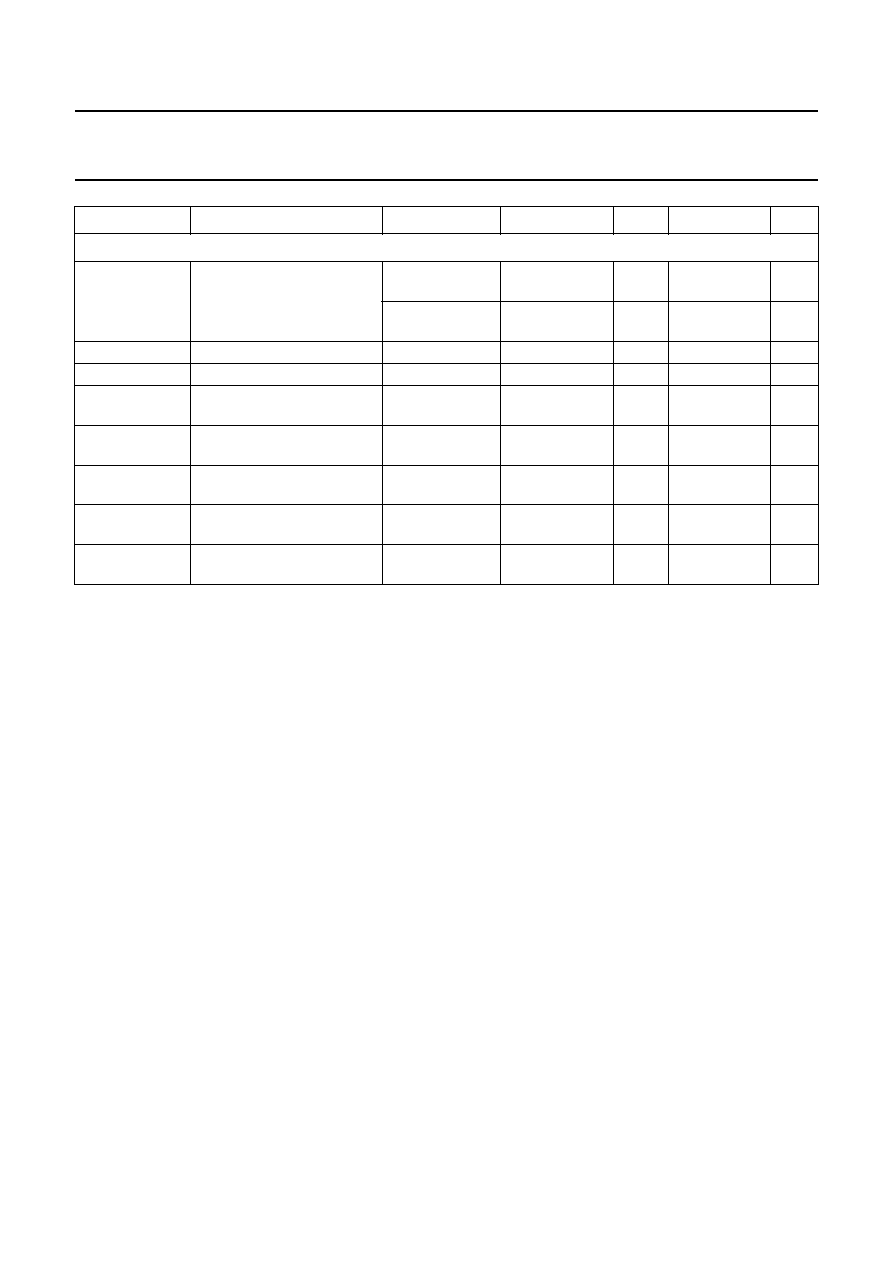
1998 Feb 16
25
Philips Semiconductors
Product specification
QIC digital equalizer
SZA1000
Notes
1. Pins 3, 4, 6, 9 to 20, 22, 23, 24, 30 and 31.
2. Measured at pins 39 and 44 with a 10 M
/15 pF load.
3. Measured at pins 40 and 43.
4. Differential pins 40 and 43.
5.
6. C
o(L)(SRD)
is the external load (pF), at SRD (pin 27) for C
o(L)(SRD)
< 50 pF.
C
o(L)(RRC)
is the external load (pF), at RRC (pin 25) for C
o(L)(RRC)
< 50 pF.
7. C
o(L)(PACLK)
is the external load (pF), at PACLK (pin 29) for C
o(L)(PACLK)
< 50 pF.
8. C
o(L)(AUX)
is the external load (pF), at AUX0 to AUX7 (pins 11 to 18) for C
o(L)(AUX)
< 50 pF.
9. C
o(L)(WDOUT)
is the external load (pF), at WDOUT (pin 11) for C
o(L)(WDOUT)
< 50 pF.
Write equalization section
f
clk(WEQ)
WEQ clock frequency
N2 = 1 or N3 = 1;
see Table 14
-
-
36
MHz
N6 =1;
see Table 14
-
24
24
MHz
t
WEQL
WEQ LOW time
10
-
-
ns
t
WEQH
WEQ HIGH time
10
-
-
ns
t
su(WD-WEQCLK)
setup time:
WDIN-to-WEQCLK
N2 = 1 or N3 = 1;
see Table 14
5
-
-
ns
t
h(WD-WEQCLK)
hold time: WD-to-WEQCLK
N2 = 1 or N3 = 1;
see Table 14
10
-
-
ns
t
IL(WDIN)
WDIN input LOW time (WDI
mode)
WDI_I = 0;
see Table 15
10
-
-
ns
t
OL(WDOUT)
WDOUT output LOW time
(WDI mode)
note 9
t
WEQH
-
2
-
0.2
◊
C
o(L)(WDOUT)
-
t
WEQH
ns
f
o(WDIN-WEQCLK)
frequency offset
WDIN-WEQCLK
N6 = 1;
see Table 14
0.5
-
-
%
SYMBOL
PARAMETER
CONDITIONS
MIN.
TYP.
MAX.
UNIT
t
s
1
f
s
----
=
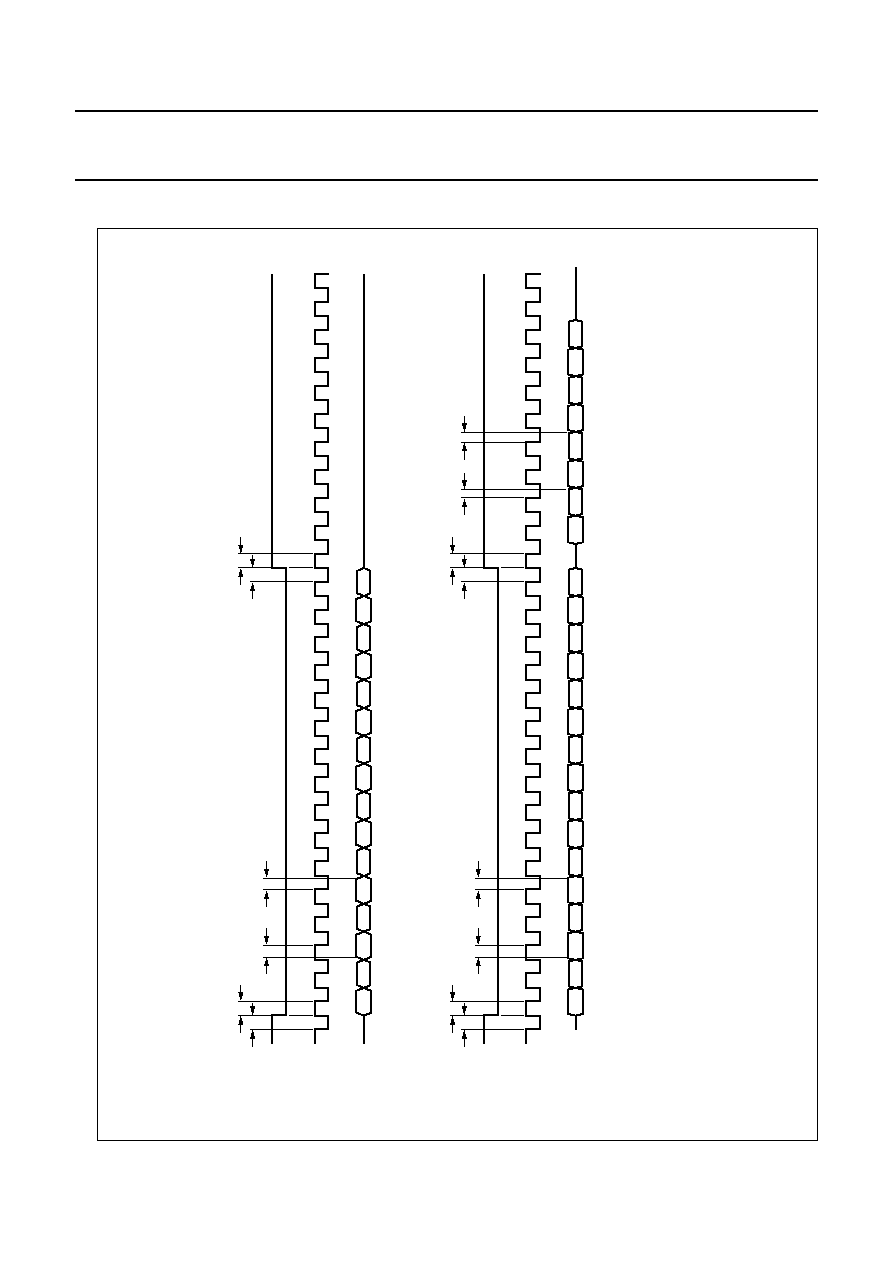
1998
Feb
16
26
Philips Semiconductors
Product specification
QIC digital equalizer
SZA1000
This text is here in white to force landscape pages to be rotated correctly when browsing through the pdf in the Acrobat reader.This text is here in
_
white to force landscape pages to be rotated correctly when browsing through the pdf in the Acrobat reader.This text is here inThis text is here in
white to force landscape pages to be rotated correctly when browsing through the pdf in the Acrobat reader. white to force landscape pages to be ...
TIMING DIAGRAMS
Serial interface
u
ll pagewidth
MGG656
A7
A6
A5
A4
A3
A2
A1
A0
D7
D6
D5
D4
D3
D2
D1
D0
3-STATE
WRITE SETTINGS
SDEN
SCLK
SDIO
A7
A6
A5
A4
A3
A2
A1
A0
D7
D6
D5
D4
D3
D2
D1
D0
D7
D6
D5
D4
D3
D2
D1
D0
3-STATE
READ STATUS
SDEN
SCLK
SDIO
ADDRESS AND DATA FROM MICROCONTROLLER
DATA OUT FROM DEVICE
th(EN-CLK)
tsu(D-CLK)
th(D-CLK)
tsu(EN-CLK)
th(EN-CLK)
tsu(EN-CLK)
th(EN-CLK)
tsu(D-CLK)
th(D-CLK)
tsu(EN-CLK)
th(EN-CLK)
tsu(EN-CLK)
td(1)
td(2)
Fig.8 Serial I/O showing set-up, hold and delay timing.
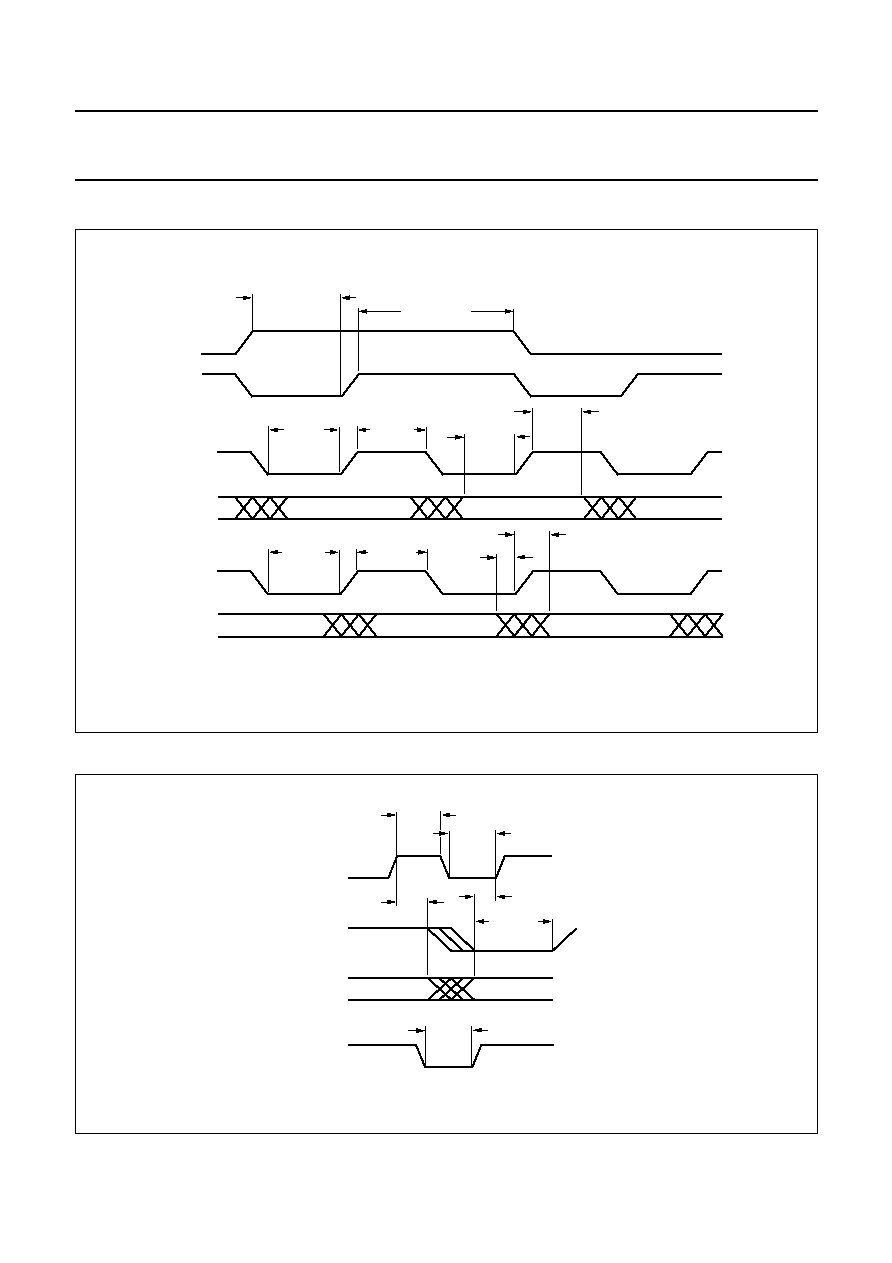
1998 Feb 16
27
Philips Semiconductors
Product specification
QIC digital equalizer
SZA1000
Digital read section
Write equalization section
Fig.9 Digital read section showing set-up, hold and delay timing.
handbook, full pagewidth
MGG657
tPACLKL
tPACLKH
td(AUX-PACLK)
td(PACLK-AUX)
tCLKINL
tCLKINH
tsu(SRD-RRC)
th(SRD-RRC)
th(AUX-CLKIN)
tsu(AUX-CLKIN)
SRD
RRC
CLKIN
AUX0 to 7
INPUT
PACLK
AUX0 to 7
OUTPUT
Fig.10 WEQ section showing set-up and hold timing.
handbook, full pagewidth
MGG658
th(WD-WEQCLK)
WEQCLK)
WDIN
(WDI mode)
WDIN
(WD mode)
WDOUT
(WDI mode)
tWEQH
tWEQL
tsu(WD-WEQCLK)
tOL(WDOUT)
tIL(WDIN)
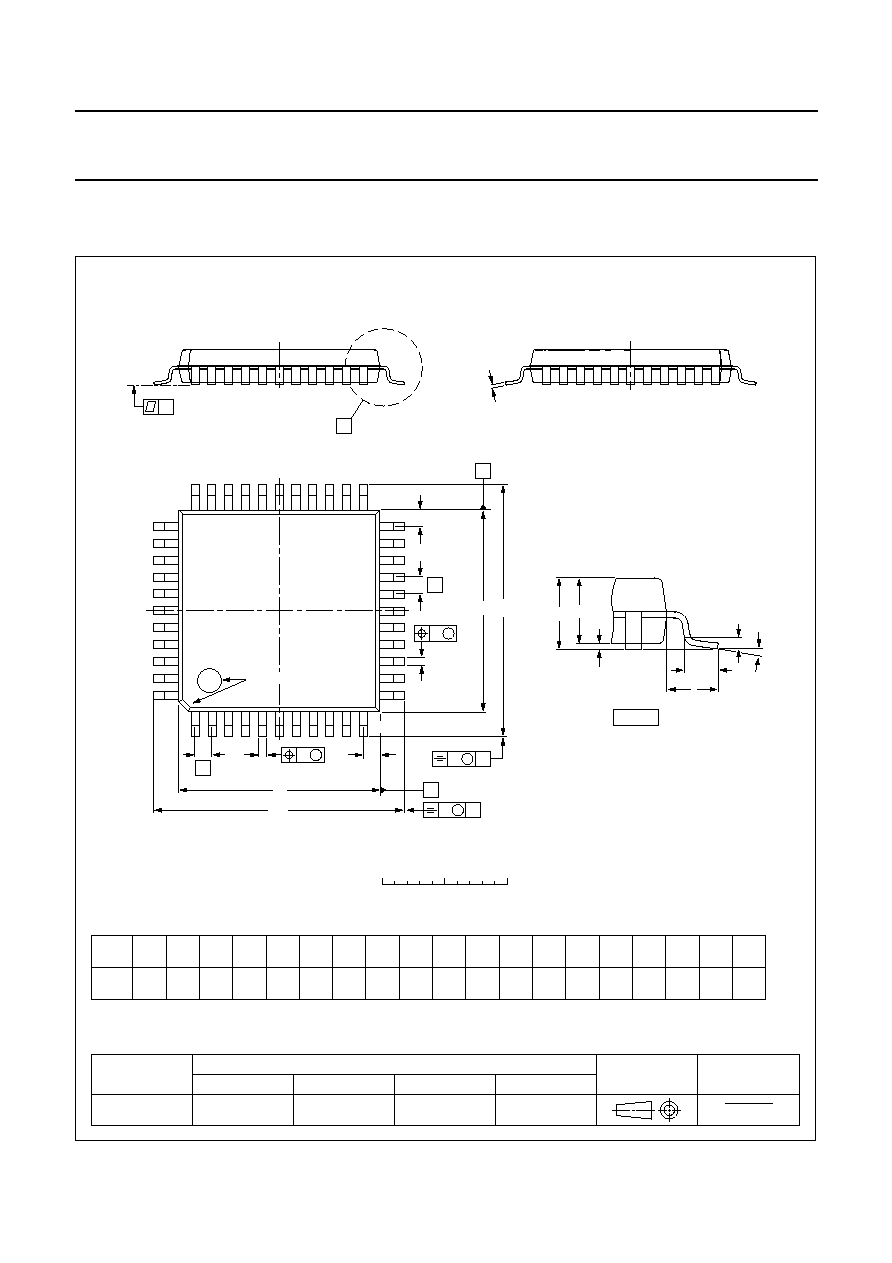
1998 Feb 16
28
Philips Semiconductors
Product specification
QIC digital equalizer
SZA1000
PACKAGE OUTLINE
UNIT
A
1
A
2
A
3
b
p
c
E
(1)
e
H
E
L
L
p
Z
y
w
v
REFERENCES
OUTLINE
VERSION
EUROPEAN
PROJECTION
ISSUE DATE
IEC
JEDEC
EIAJ
mm
0.25
0.05
1.85
1.65
0.25
0.40
0.20
0.25
0.14
10.1
9.9
0.8
1.3
12.9
12.3
1.2
0.8
10
0
o
o
0.15
0.1
0.15
DIMENSIONS (mm are the original dimensions)
Note
1. Plastic or metal protrusions of 0.25 mm maximum per side are not included.
0.95
0.55
SOT307-2
95-02-04
97-08-01
D
(1)
(1)
(1)
10.1
9.9
H
D
12.9
12.3
E
Z
1.2
0.8
D
e
E
B
11
c
E
H
D
ZD
A
Z E
e
v
M
A
X
1
44
34
33
23
22
12
y
A
1
A
L
p
detail X
L
(A )
3
A
2
pin 1 index
D
H
v
M
B
b
p
b
p
w
M
w
M
0
2.5
5 mm
scale
QFP44: plastic quad flat package; 44 leads (lead length 1.3 mm); body 10 x 10 x 1.75 mm
SOT307-2
A
max.
2.10

1998 Feb 16
29
Philips Semiconductors
Product specification
QIC digital equalizer
SZA1000
SOLDERING
Introduction
There is no soldering method that is ideal for all IC
packages. Wave soldering is often preferred when
through-hole and surface mounted components are mixed
on one printed-circuit board. However, wave soldering is
not always suitable for surface mounted ICs, or for
printed-circuits with high population densities. In these
situations reflow soldering is often used.
This text gives a very brief insight to a complex technology.
A more in-depth account of soldering ICs can be found in
our
"IC Package Databook" (order code 9398 652 90011).
Reflow soldering
Reflow soldering techniques are suitable for all QFP
packages.
The choice of heating method may be influenced by larger
plastic QFP packages (44 leads, or more). If infrared or
vapour phase heating is used and the large packages are
not absolutely dry (less than 0.1% moisture content by
weight), vaporization of the small amount of moisture in
them can cause cracking of the plastic body. For more
information, refer to the Drypack chapter in our
"Quality
Reference Handbook" (order code 9397 750 00192).
Reflow soldering requires solder paste (a suspension of
fine solder particles, flux and binding agent) to be applied
to the printed-circuit board by screen printing, stencilling or
pressure-syringe dispensing before package placement.
Several methods exist for reflowing; for example,
infrared/convection heating in a conveyor type oven.
Throughput times (preheating, soldering and cooling) vary
between 50 and 300 seconds depending on heating
method. Typical reflow peak temperatures range from
215 to 250
∞
C.
Wave soldering
Wave soldering is not recommended for QFP packages.
This is because of the likelihood of solder bridging due to
closely-spaced leads and the possibility of incomplete
solder penetration in multi-lead devices.
CAUTION
Wave soldering is NOT applicable for all QFP
packages with a pitch (e) equal or less than 0.5 mm.
If wave soldering cannot be avoided, for QFP
packages with a pitch (e) larger than 0.5 mm, the
following conditions must be observed:
∑
A double-wave (a turbulent wave with high upward
pressure followed by a smooth laminar wave)
soldering technique should be used.
∑
The footprint must be at an angle of 45
∞
to the board
direction and must incorporate solder thieves
downstream and at the side corners.
During placement and before soldering, the package must
be fixed with a droplet of adhesive. The adhesive can be
applied by screen printing, pin transfer or syringe
dispensing. The package can be soldered after the
adhesive is cured.
Maximum permissible solder temperature is 260
∞
C, and
maximum duration of package immersion in solder is
10 seconds, if cooled to less than 150
∞
C within
6 seconds. Typical dwell time is 4 seconds at 250
∞
C.
A mildly-activated flux will eliminate the need for removal
of corrosive residues in most applications.
Repairing soldered joints
Fix the component by first soldering two diagonally-
opposite end leads. Use only a low voltage soldering iron
(less than 24 V) applied to the flat part of the lead. Contact
time must be limited to 10 seconds at up to 300
∞
C. When
using a dedicated tool, all other leads can be soldered in
one operation within 2 to 5 seconds between
270 and 320
∞
C.

1998 Feb 16
30
Philips Semiconductors
Product specification
QIC digital equalizer
SZA1000
DEFINITIONS
LIFE SUPPORT APPLICATIONS
These products are not designed for use in life support appliances, devices, or systems where malfunction of these
products can reasonably be expected to result in personal injury. Philips customers using or selling these products for
use in such applications do so at their own risk and agree to fully indemnify Philips for any damages resulting from such
improper use or sale.
Data sheet status
Objective specification
This data sheet contains target or goal specifications for product development.
Preliminary specification
This data sheet contains preliminary data; supplementary data may be published later.
Product specification
This data sheet contains final product specifications.
Limiting values
Limiting values given are in accordance with the Absolute Maximum Rating System (IEC 134). Stress above one or
more of the limiting values may cause permanent damage to the device. These are stress ratings only and operation
of the device at these or at any other conditions above those given in the Characteristics sections of the specification
is not implied. Exposure to limiting values for extended periods may affect device reliability.
Application information
Where application information is given, it is advisory and does not form part of the specification.

1998 Feb 16
31
Philips Semiconductors
Product specification
QIC digital equalizer
SZA1000
NOTES

Internet: http://www.semiconductors.philips.com
Philips Semiconductors ≠ a worldwide company
© Philips Electronics N.V. 1998
SCA57
All rights are reserved. Reproduction in whole or in part is prohibited without the prior written consent of the copyright owner.
The information presented in this document does not form part of any quotation or contract, is believed to be accurate and reliable and may be changed
without notice. No liability will be accepted by the publisher for any consequence of its use. Publication thereof does not convey nor imply any license
under patent- or other industrial or intellectual property rights.
Netherlands: Postbus 90050, 5600 PB EINDHOVEN, Bldg. VB,
Tel. +31 40 27 82785, Fax. +31 40 27 88399
New Zealand: 2 Wagener Place, C.P.O. Box 1041, AUCKLAND,
Tel. +64 9 849 4160, Fax. +64 9 849 7811
Norway: Box 1, Manglerud 0612, OSLO,
Tel. +47 22 74 8000, Fax. +47 22 74 8341
Philippines: Philips Semiconductors Philippines Inc.,
106 Valero St. Salcedo Village, P.O. Box 2108 MCC, MAKATI,
Metro MANILA, Tel. +63 2 816 6380, Fax. +63 2 817 3474
Poland: Ul. Lukiska 10, PL 04-123 WARSZAWA,
Tel. +48 22 612 2831, Fax. +48 22 612 2327
Portugal: see Spain
Romania: see Italy
Russia: Philips Russia, Ul. Usatcheva 35A, 119048 MOSCOW,
Tel. +7 095 755 6918, Fax. +7 095 755 6919
Singapore: Lorong 1, Toa Payoh, SINGAPORE 1231,
Tel. +65 350 2538, Fax. +65 251 6500
Slovakia: see Austria
Slovenia: see Italy
South Africa: S.A. PHILIPS Pty Ltd., 195-215 Main Road Martindale,
2092 JOHANNESBURG, P.O. Box 7430 Johannesburg 2000,
Tel. +27 11 470 5911, Fax. +27 11 470 5494
South America: Al. Vicente Pinzon, 173, 6th floor,
04547-130 S√O PAULO, SP, Brazil,
Tel. +55 11 821 2333, Fax. +55 11 821 2382
Spain: Balmes 22, 08007 BARCELONA,
Tel. +34 3 301 6312, Fax. +34 3 301 4107
Sweden: Kottbygatan 7, Akalla, S-16485 STOCKHOLM,
Tel. +46 8 632 2000, Fax. +46 8 632 2745
Switzerland: Allmendstrasse 140, CH-8027 ZÐRICH,
Tel. +41 1 488 2686, Fax. +41 1 488 3263
Taiwan: Philips Semiconductors, 6F, No. 96, Chien Kuo N. Rd., Sec. 1,
TAIPEI, Taiwan Tel. +886 2 2134 2865, Fax. +886 2 2134 2874
Thailand: PHILIPS ELECTRONICS (THAILAND) Ltd.,
209/2 Sanpavuth-Bangna Road Prakanong, BANGKOK 10260,
Tel. +66 2 745 4090, Fax. +66 2 398 0793
Turkey: Talatpasa Cad. No. 5, 80640 GÐLTEPE/ISTANBUL,
Tel. +90 212 279 2770, Fax. +90 212 282 6707
Ukraine: PHILIPS UKRAINE, 4 Patrice Lumumba str., Building B, Floor 7,
252042 KIEV, Tel. +380 44 264 2776, Fax. +380 44 268 0461
United Kingdom: Philips Semiconductors Ltd., 276 Bath Road, Hayes,
MIDDLESEX UB3 5BX, Tel. +44 181 730 5000, Fax. +44 181 754 8421
United States: 811 East Arques Avenue, SUNNYVALE, CA 94088-3409,
Tel. +1 800 234 7381
Uruguay: see South America
Vietnam: see Singapore
Yugoslavia: PHILIPS, Trg N. Pasica 5/v, 11000 BEOGRAD,
Tel. +381 11 625 344, Fax.+381 11 635 777
For all other countries apply to: Philips Semiconductors,
International Marketing & Sales Communications, Building BE-p, P.O. Box 218,
5600 MD EINDHOVEN, The Netherlands, Fax. +31 40 27 24825
Argentina: see South America
Australia: 34 Waterloo Road, NORTH RYDE, NSW 2113,
Tel. +61 2 9805 4455, Fax. +61 2 9805 4466
Austria: Computerstr. 6, A-1101 WIEN, P.O. Box 213, Tel. +43 160 1010,
Fax. +43 160 101 1210
Belarus: Hotel Minsk Business Center, Bld. 3, r. 1211, Volodarski Str. 6,
220050 MINSK, Tel. +375 172 200 733, Fax. +375 172 200 773
Belgium: see The Netherlands
Brazil: see South America
Bulgaria: Philips Bulgaria Ltd., Energoproject, 15th floor,
51 James Bourchier Blvd., 1407 SOFIA,
Tel. +359 2 689 211, Fax. +359 2 689 102
Canada: PHILIPS SEMICONDUCTORS/COMPONENTS,
Tel. +1 800 234 7381
China/Hong Kong: 501 Hong Kong Industrial Technology Centre,
72 Tat Chee Avenue, Kowloon Tong, HONG KONG,
Tel. +852 2319 7888, Fax. +852 2319 7700
Colombia: see South America
Czech Republic: see Austria
Denmark: Prags Boulevard 80, PB 1919, DK-2300 COPENHAGEN S,
Tel. +45 32 88 2636, Fax. +45 31 57 0044
Finland: Sinikalliontie 3, FIN-02630 ESPOO,
Tel. +358 9 615800, Fax. +358 9 61580920
France: 51 Rue Carnot, BP317, 92156 SURESNES Cedex,
Tel. +33 1 40 99 6161, Fax. +33 1 40 99 6427
Germany: Hammerbrookstraþe 69, D-20097 HAMBURG,
Tel. +49 40 23 53 60, Fax. +49 40 23 536 300
Greece: No. 15, 25th March Street, GR 17778 TAVROS/ATHENS,
Tel. +30 1 4894 339/239, Fax. +30 1 4814 240
Hungary: see Austria
India: Philips INDIA Ltd, Band Box Building, 2nd floor,
254-D, Dr. Annie Besant Road, Worli, MUMBAI 400 025,
Tel. +91 22 493 8541, Fax. +91 22 493 0966
Indonesia: see Singapore
Ireland: Newstead, Clonskeagh, DUBLIN 14,
Tel. +353 1 7640 000, Fax. +353 1 7640 200
Israel: RAPAC Electronics, 7 Kehilat Saloniki St, PO Box 18053,
TEL AVIV 61180, Tel. +972 3 645 0444, Fax. +972 3 649 1007
Italy: PHILIPS SEMICONDUCTORS, Piazza IV Novembre 3,
20124 MILANO, Tel. +39 2 6752 2531, Fax. +39 2 6752 2557
Japan: Philips Bldg 13-37, Kohnan 2-chome, Minato-ku, TOKYO 108,
Tel. +81 3 3740 5130, Fax. +81 3 3740 5077
Korea: Philips House, 260-199 Itaewon-dong, Yongsan-ku, SEOUL,
Tel. +82 2 709 1412, Fax. +82 2 709 1415
Malaysia: No. 76 Jalan Universiti, 46200 PETALING JAYA, SELANGOR,
Tel. +60 3 750 5214, Fax. +60 3 757 4880
Mexico: 5900 Gateway East, Suite 200, EL PASO, TEXAS 79905,
Tel. +9-5 800 234 7381
Middle East: see Italy
Printed in The Netherlands
545102/00/01/pp32
Date of release: 1998 Feb 16
Document order number:
9397 750 01122































